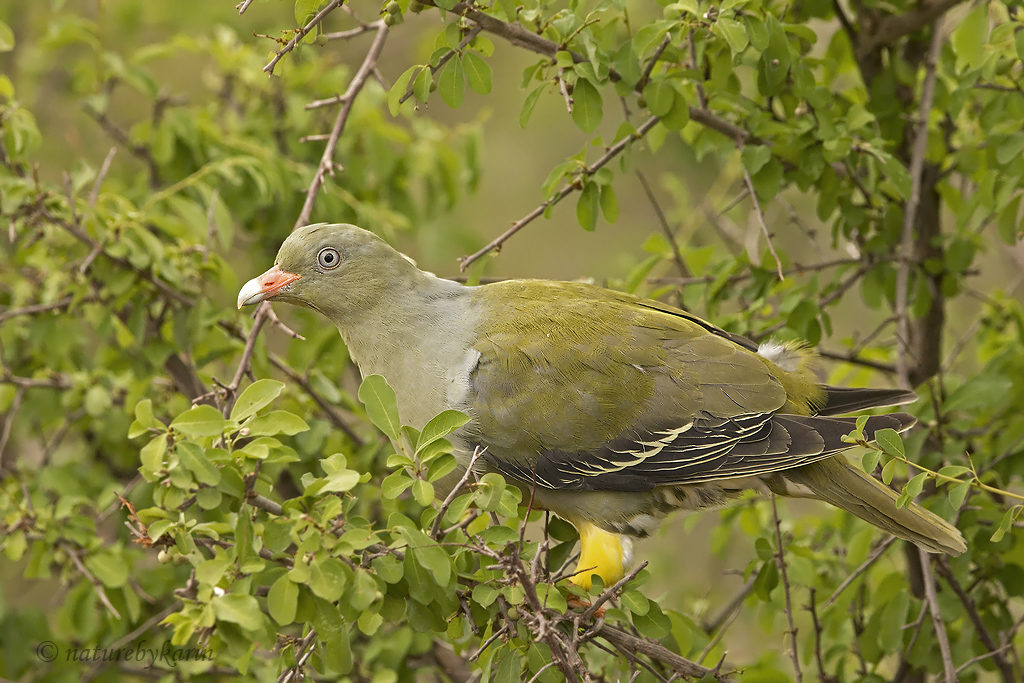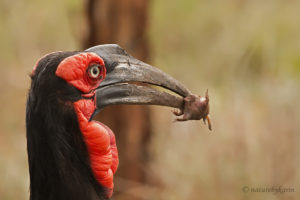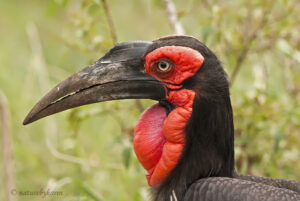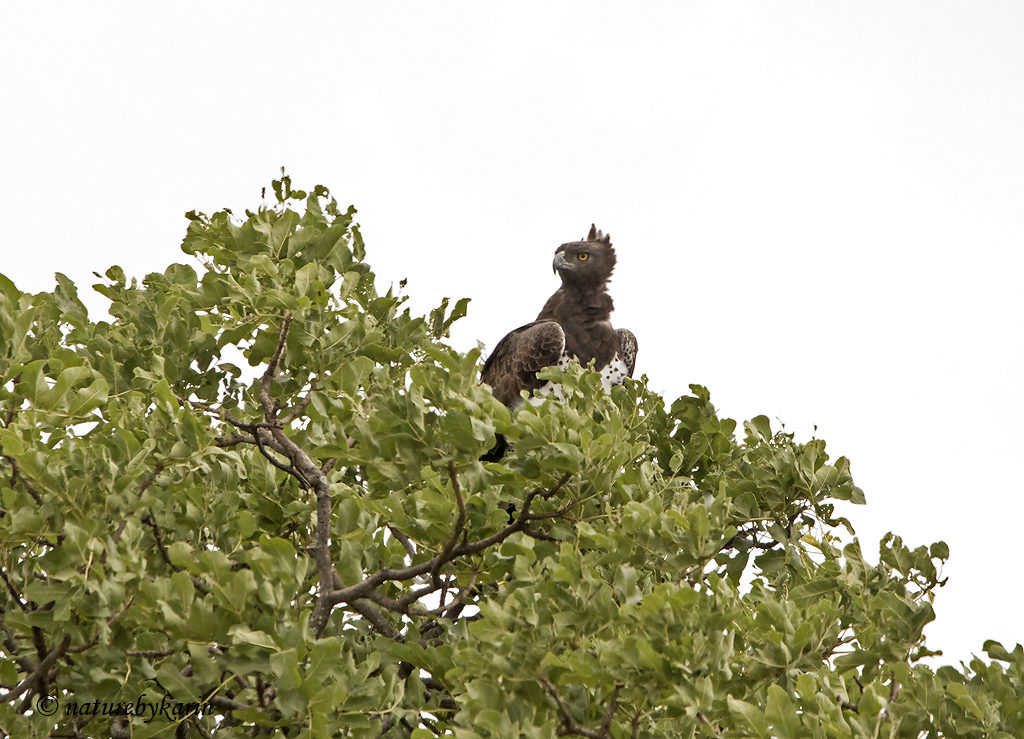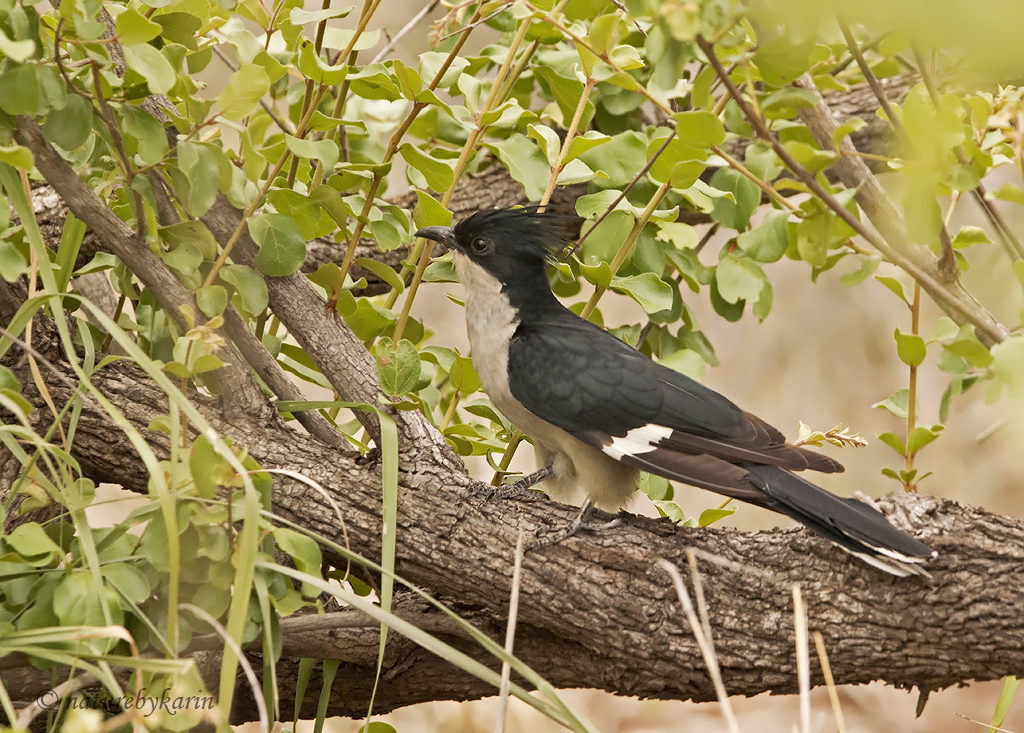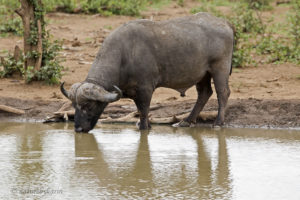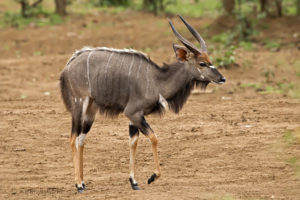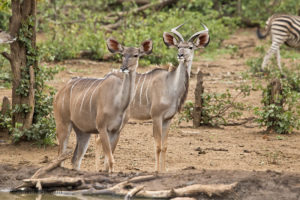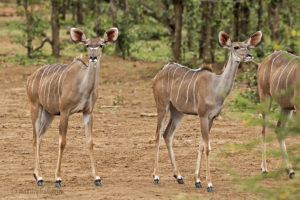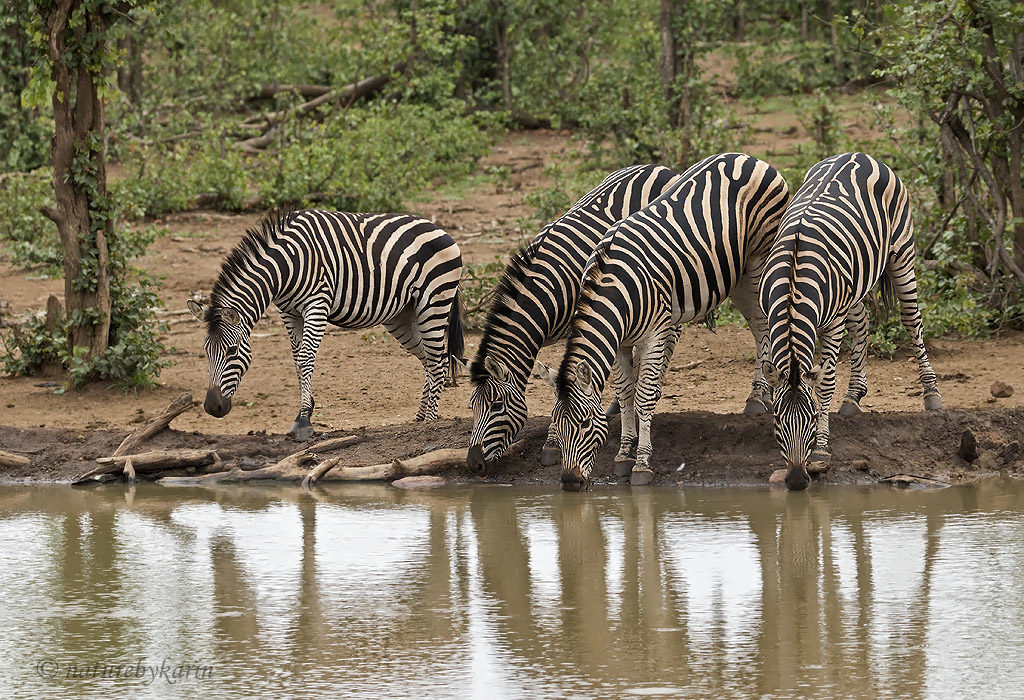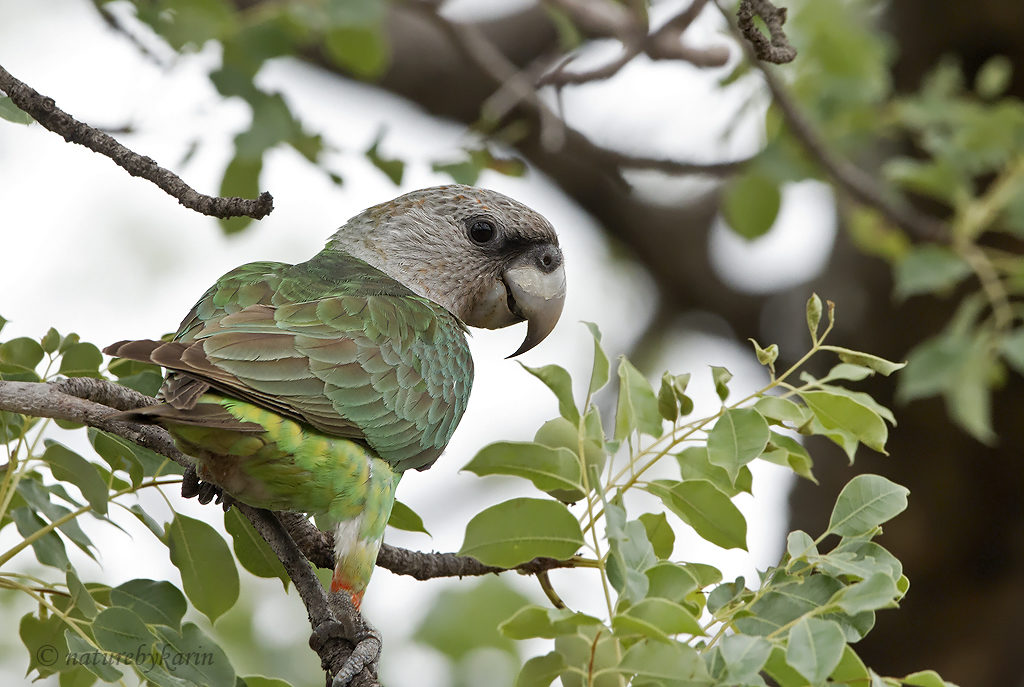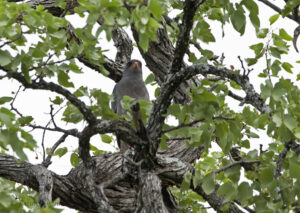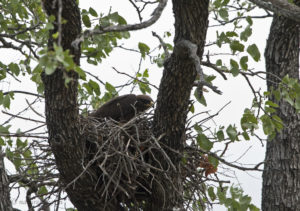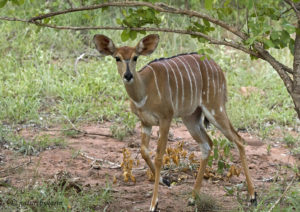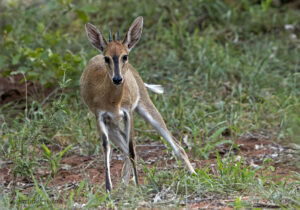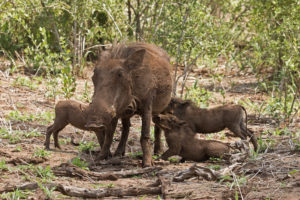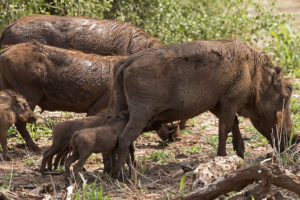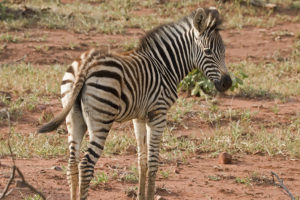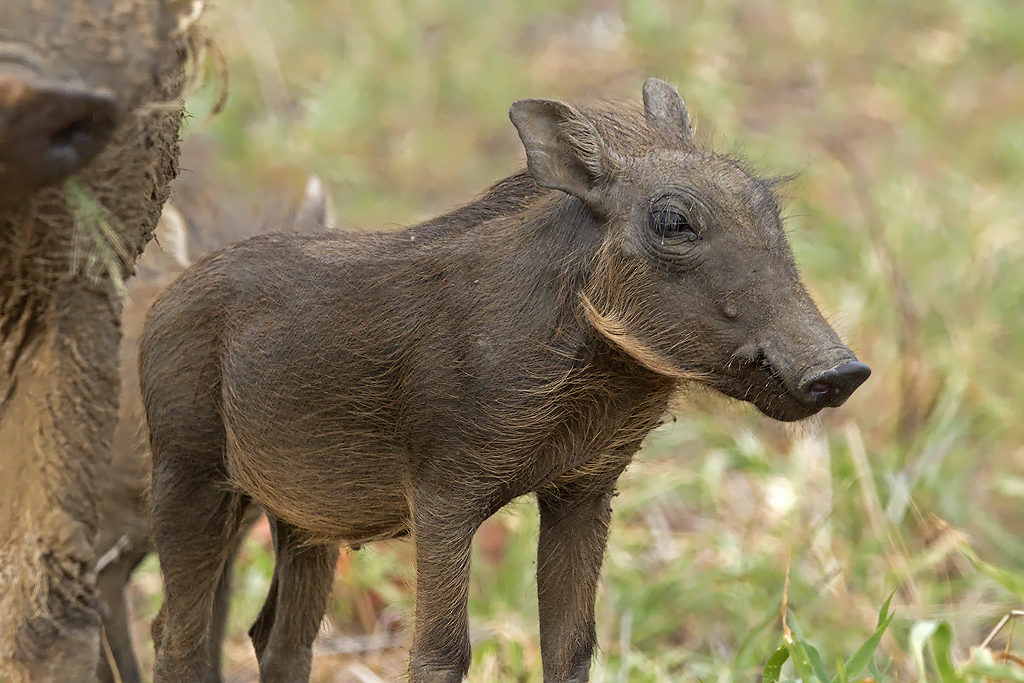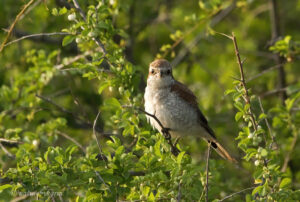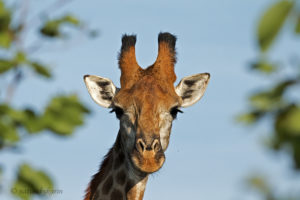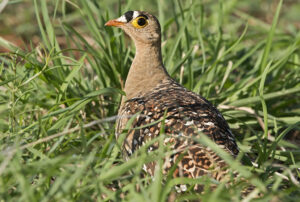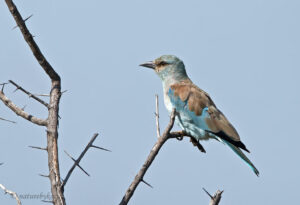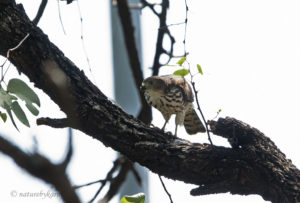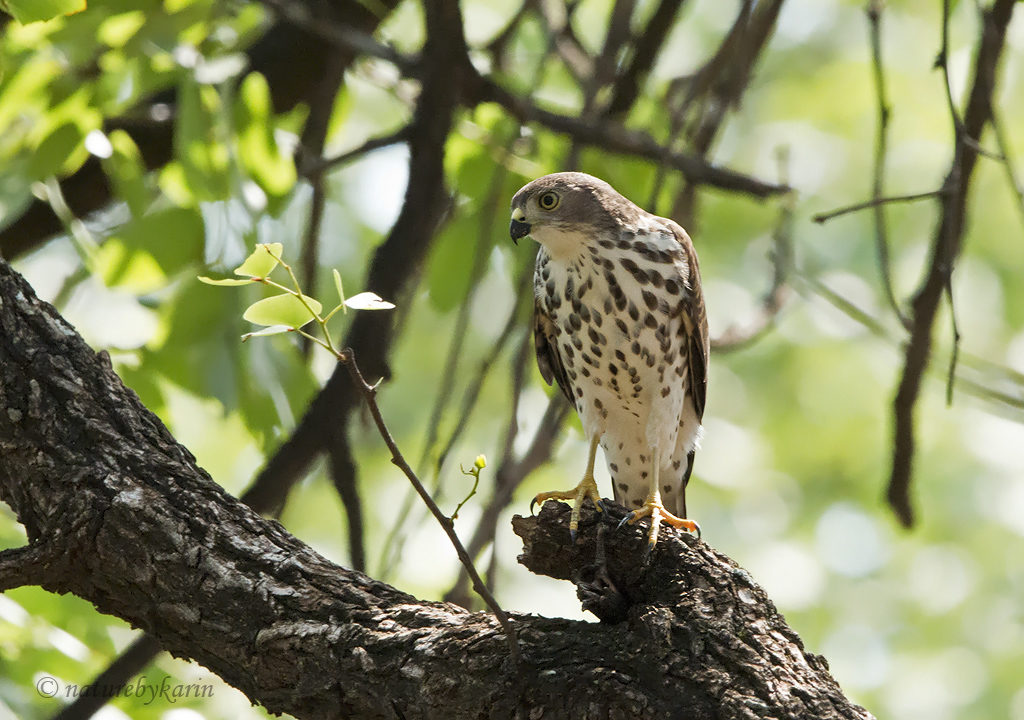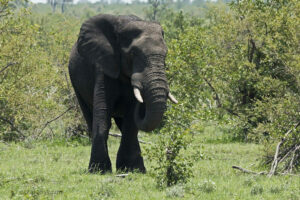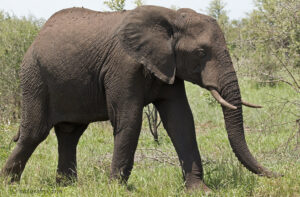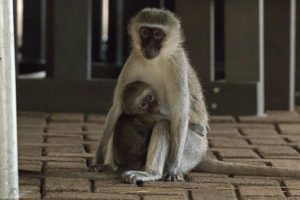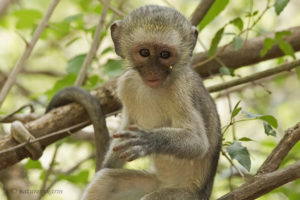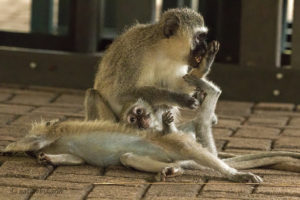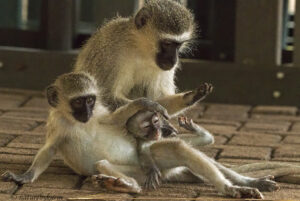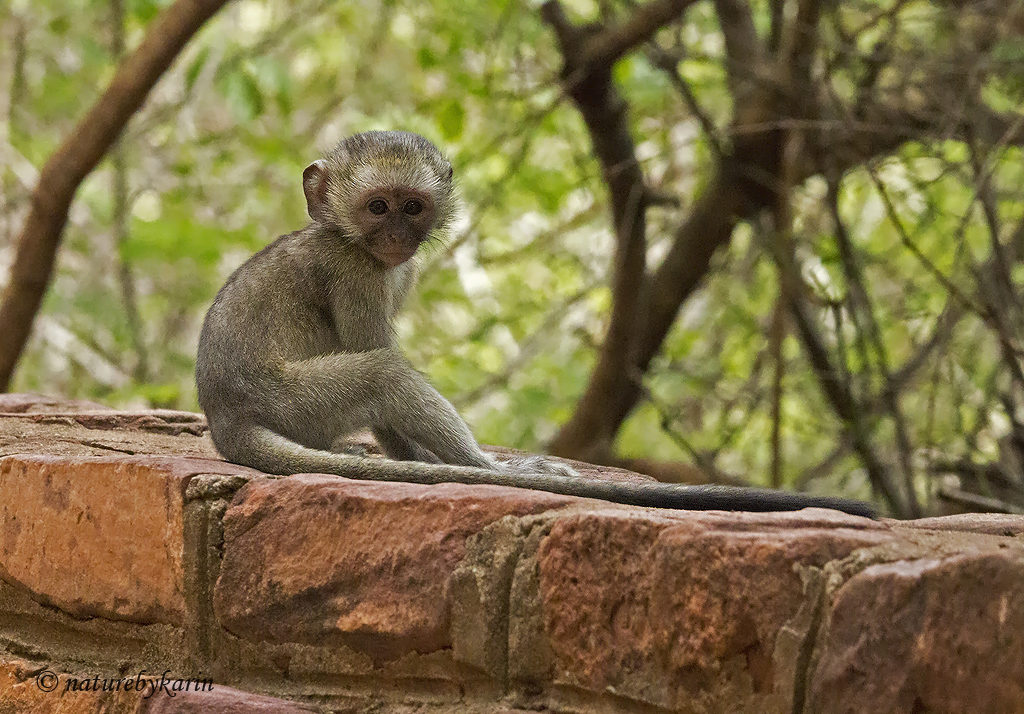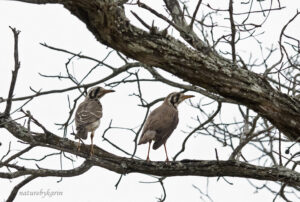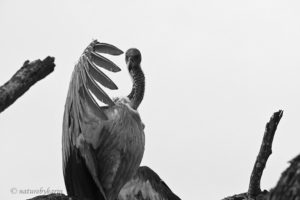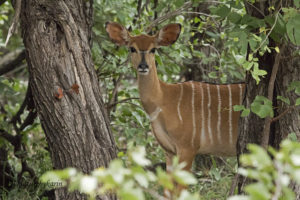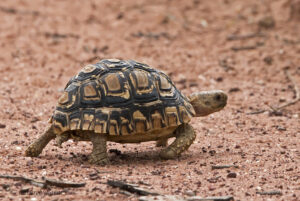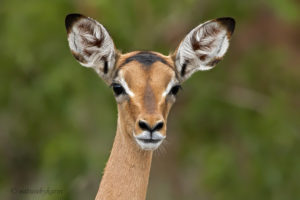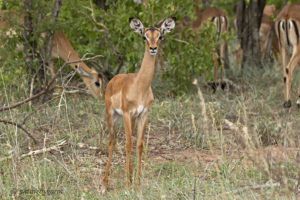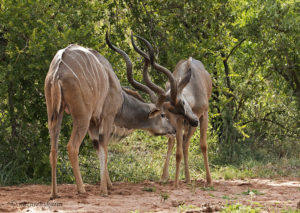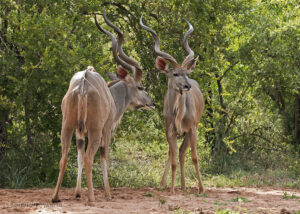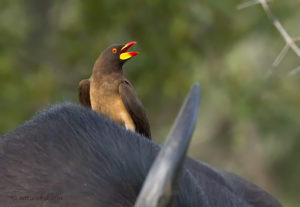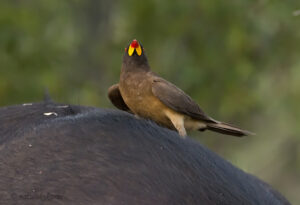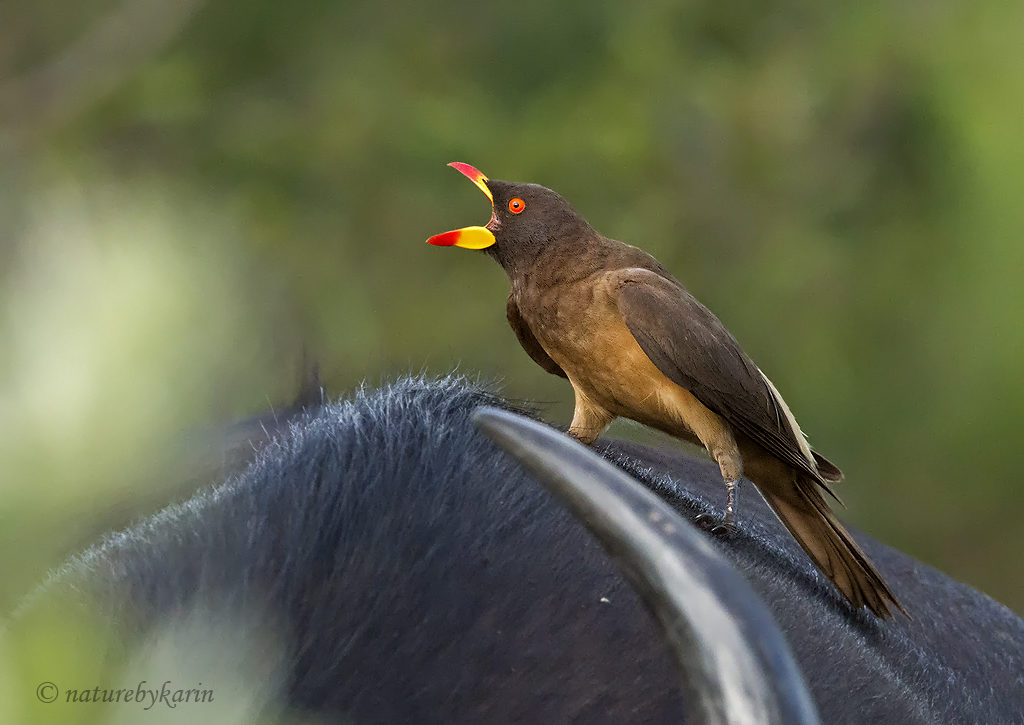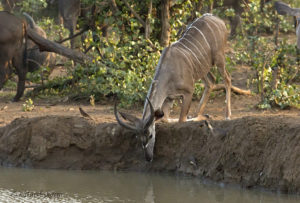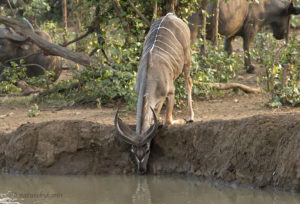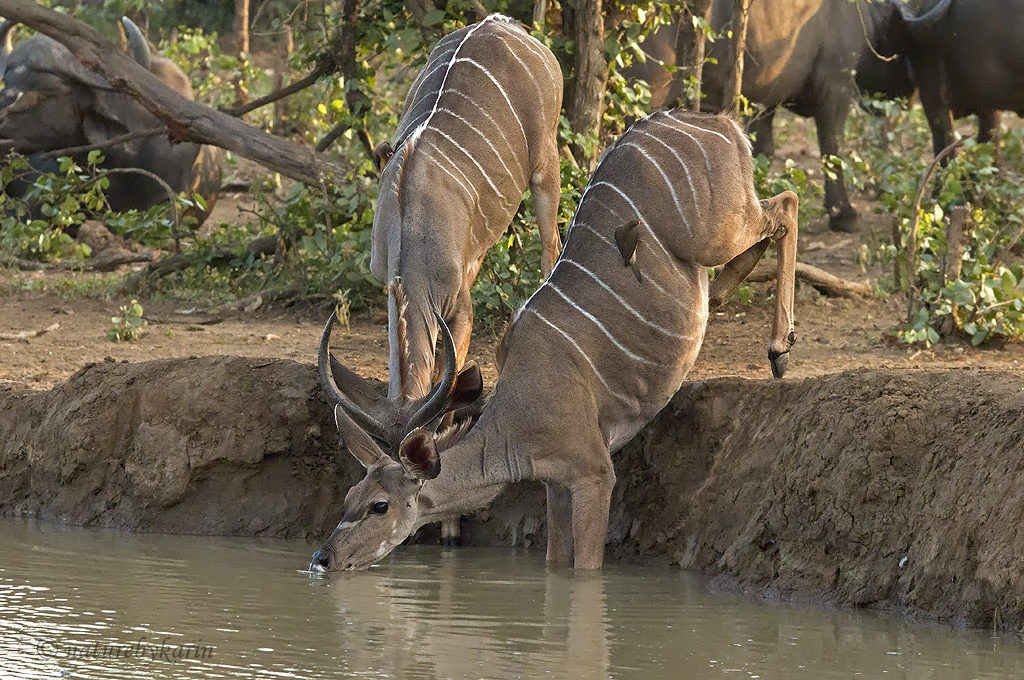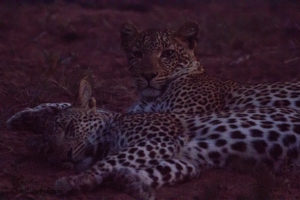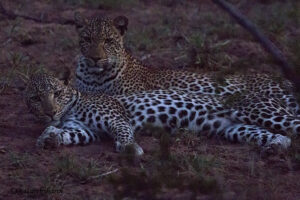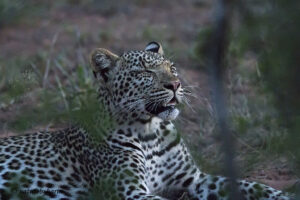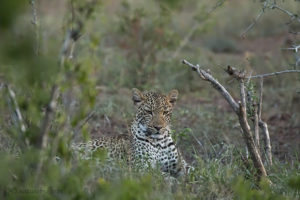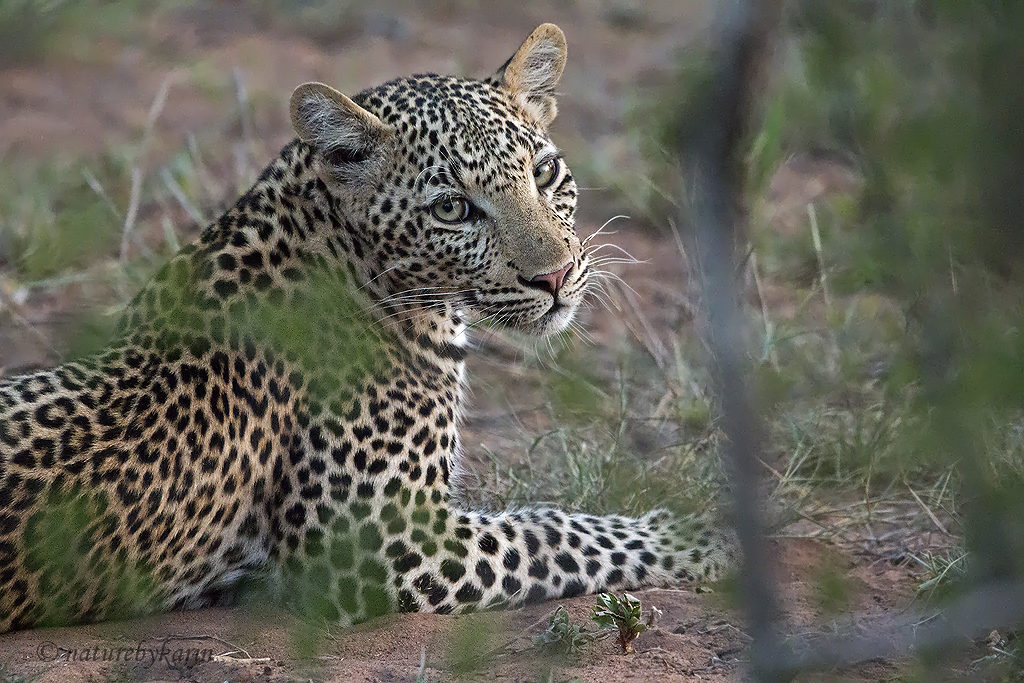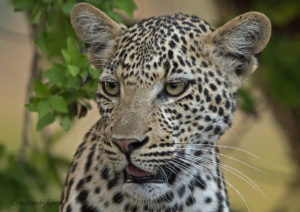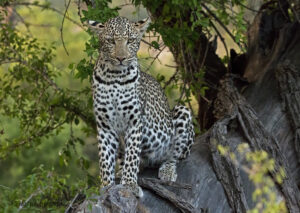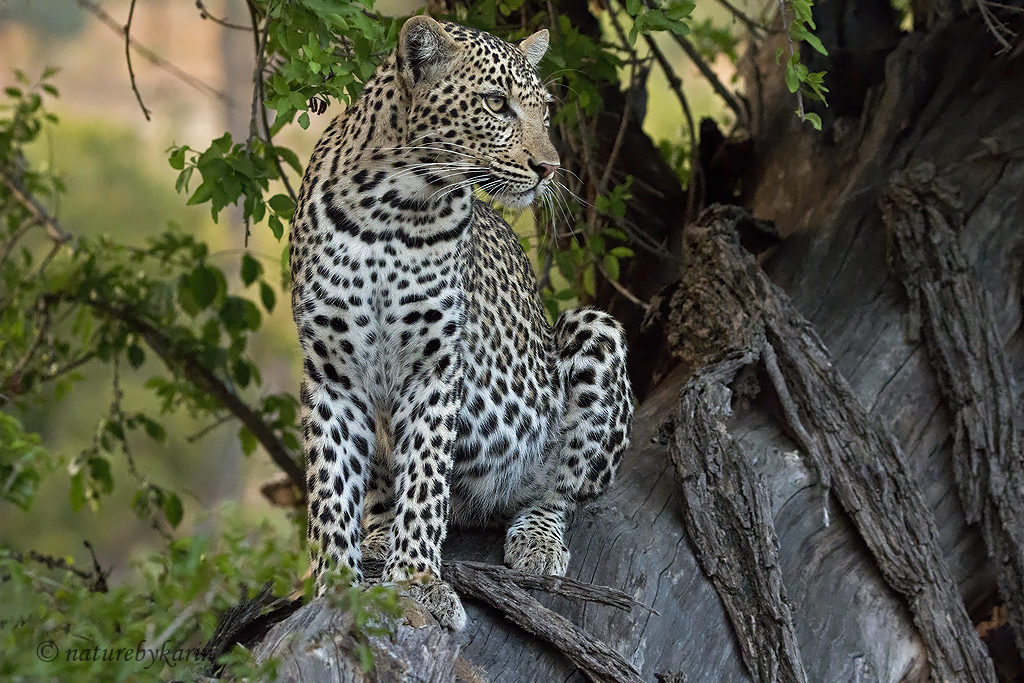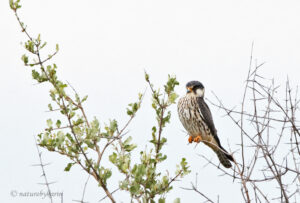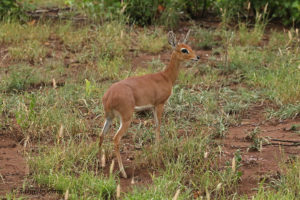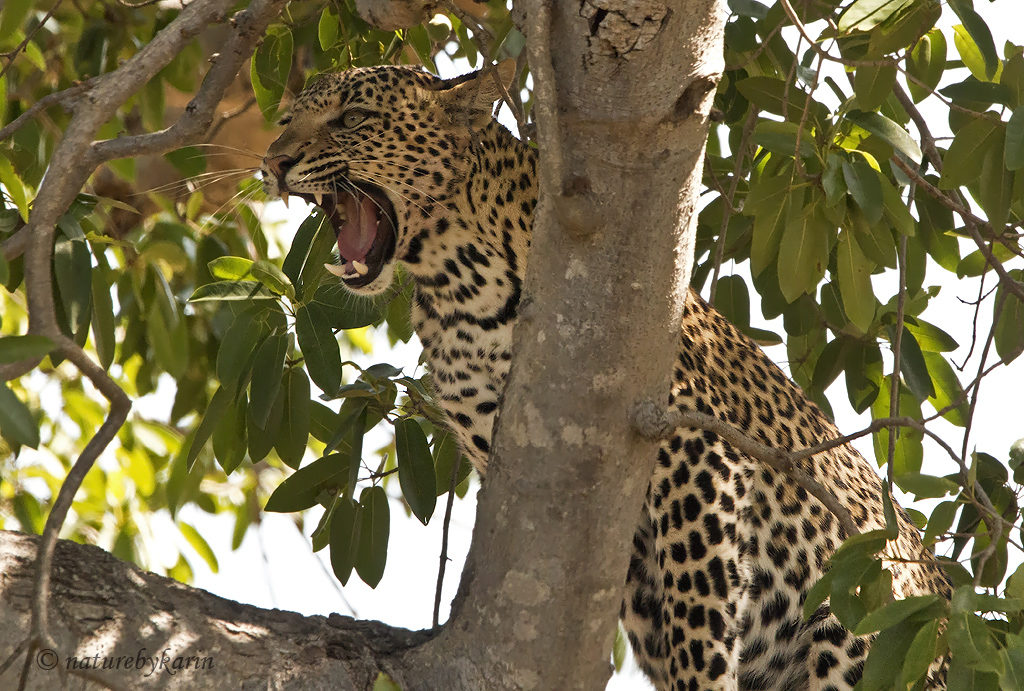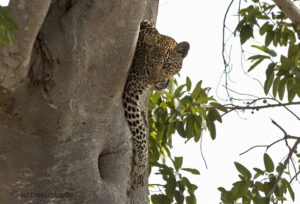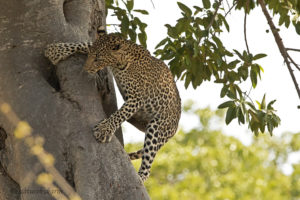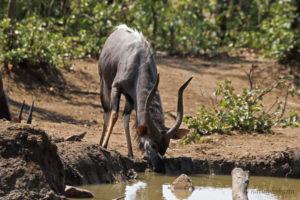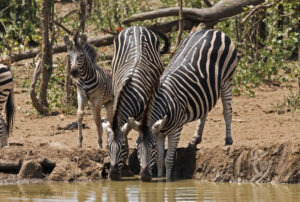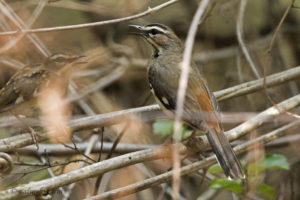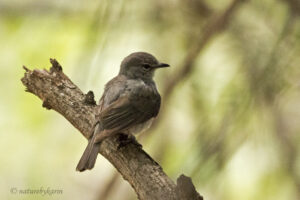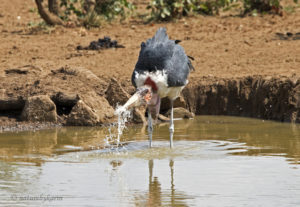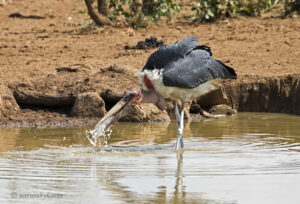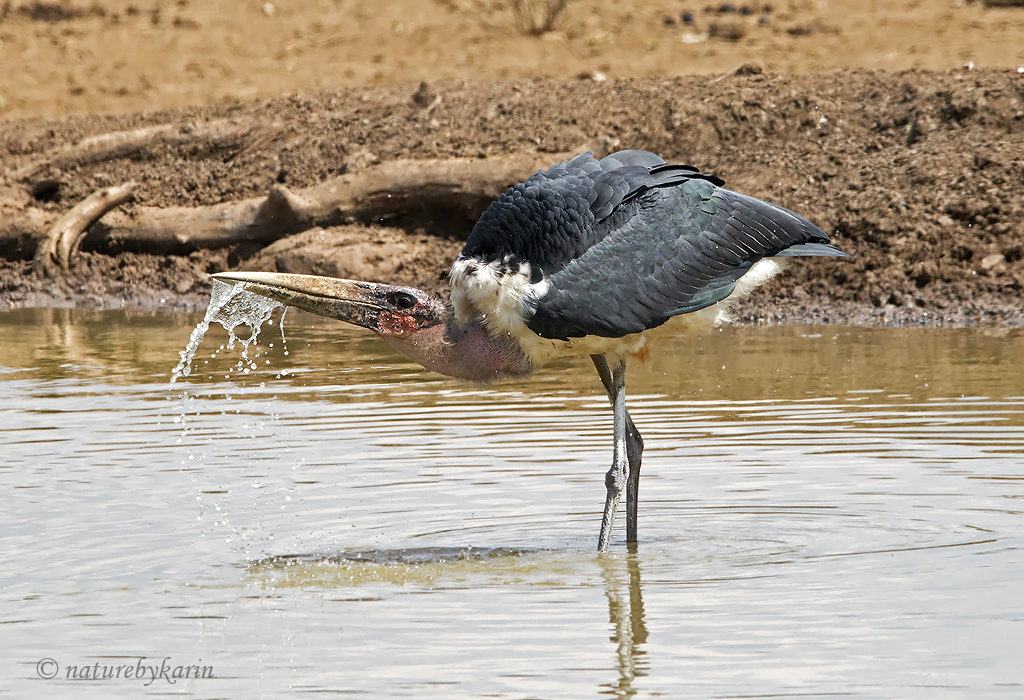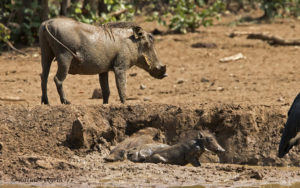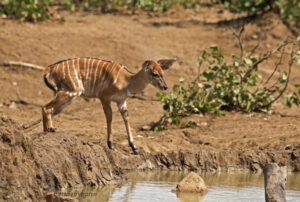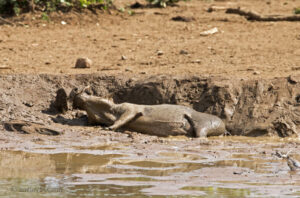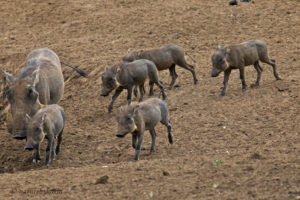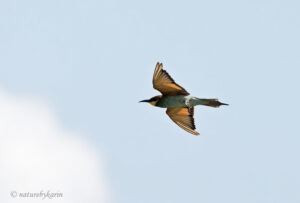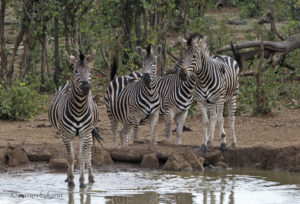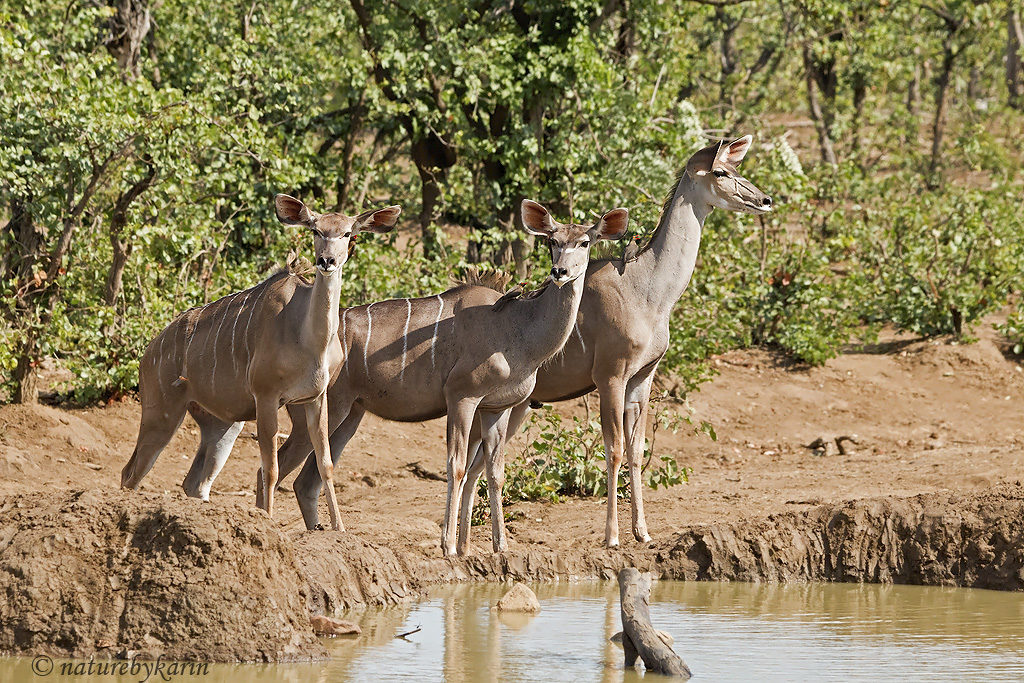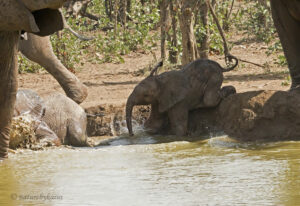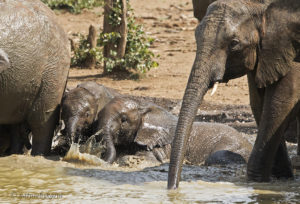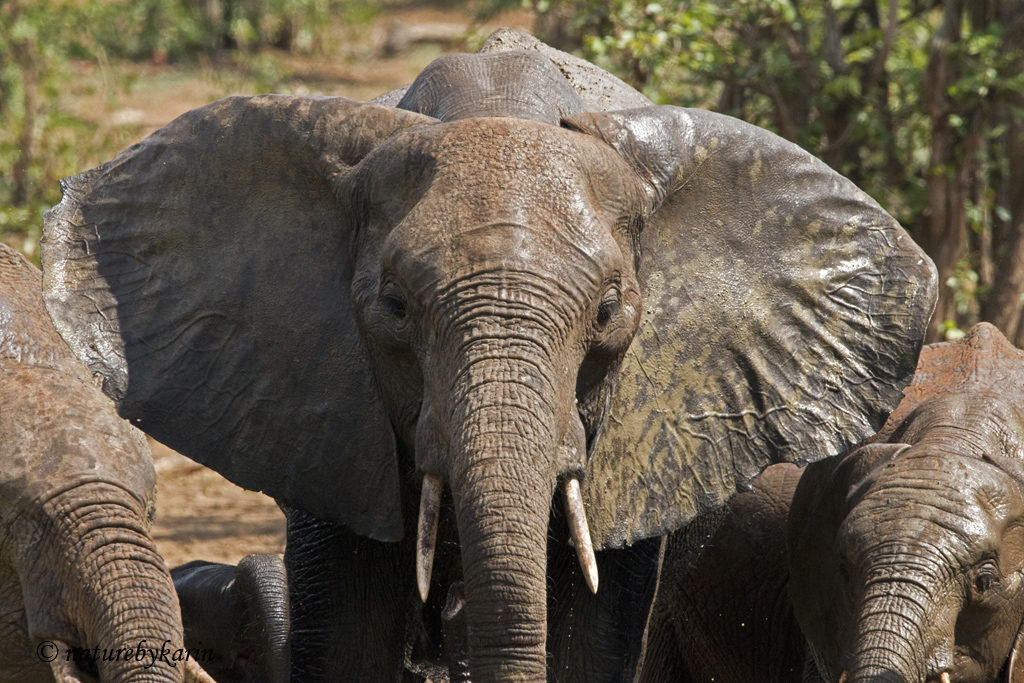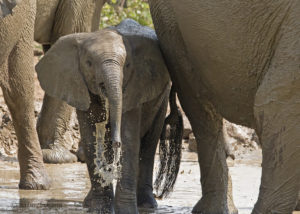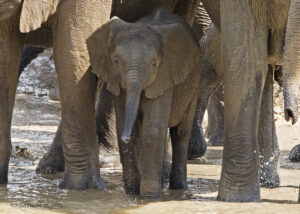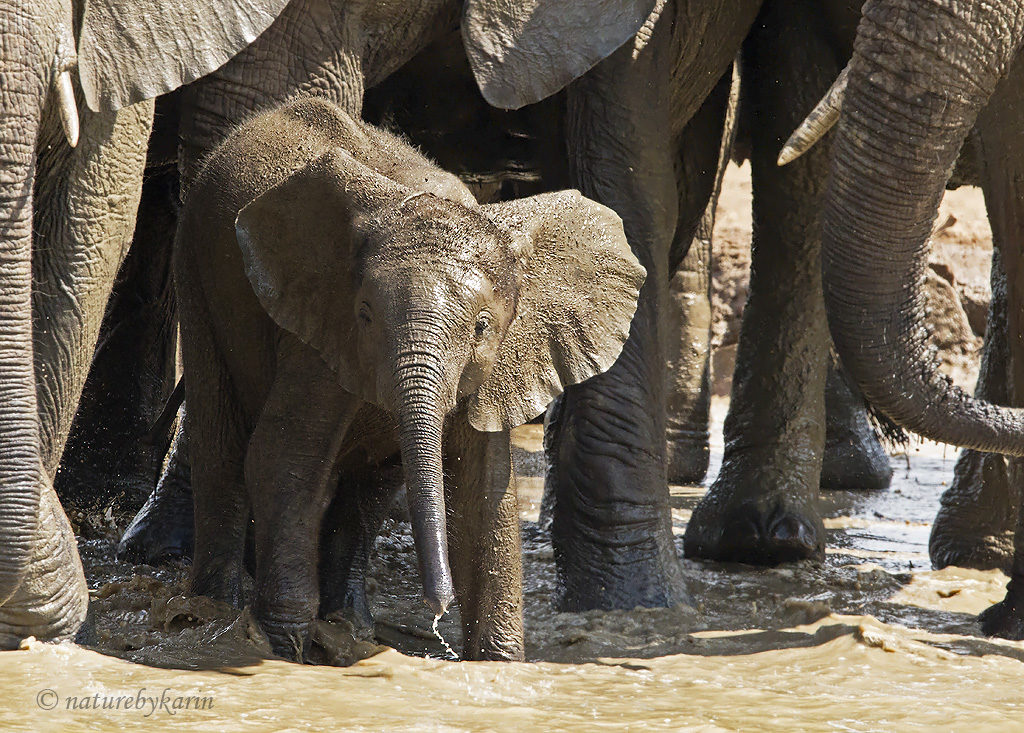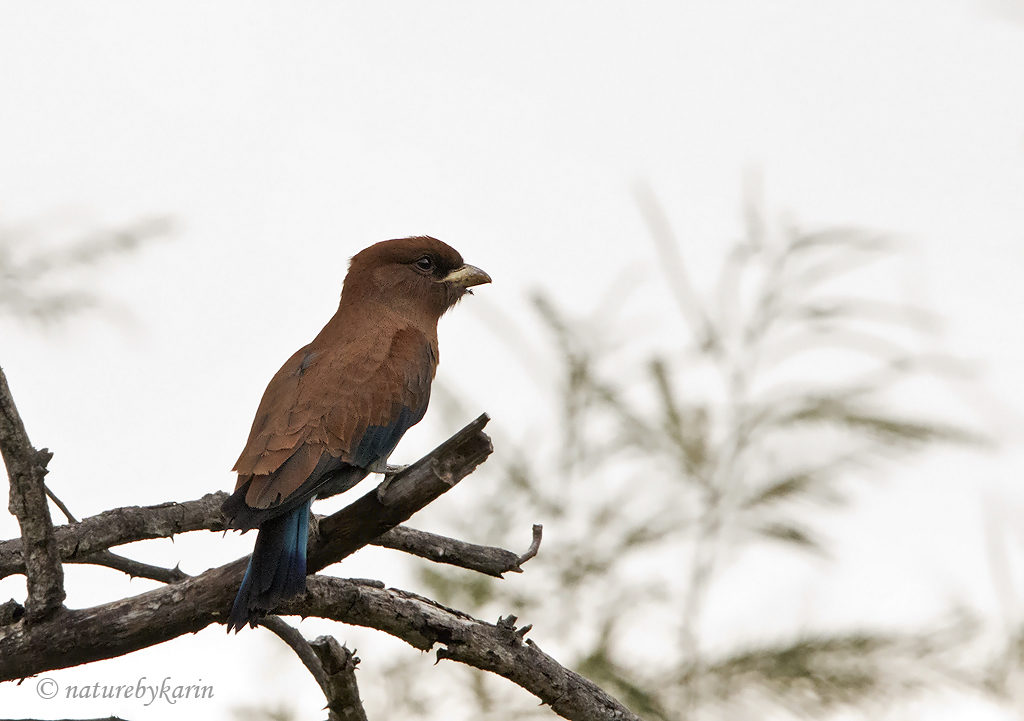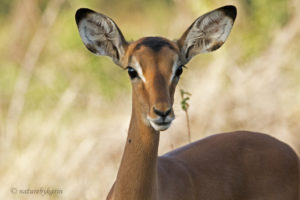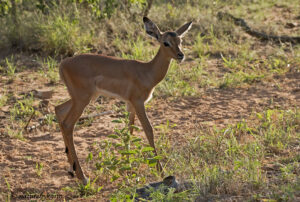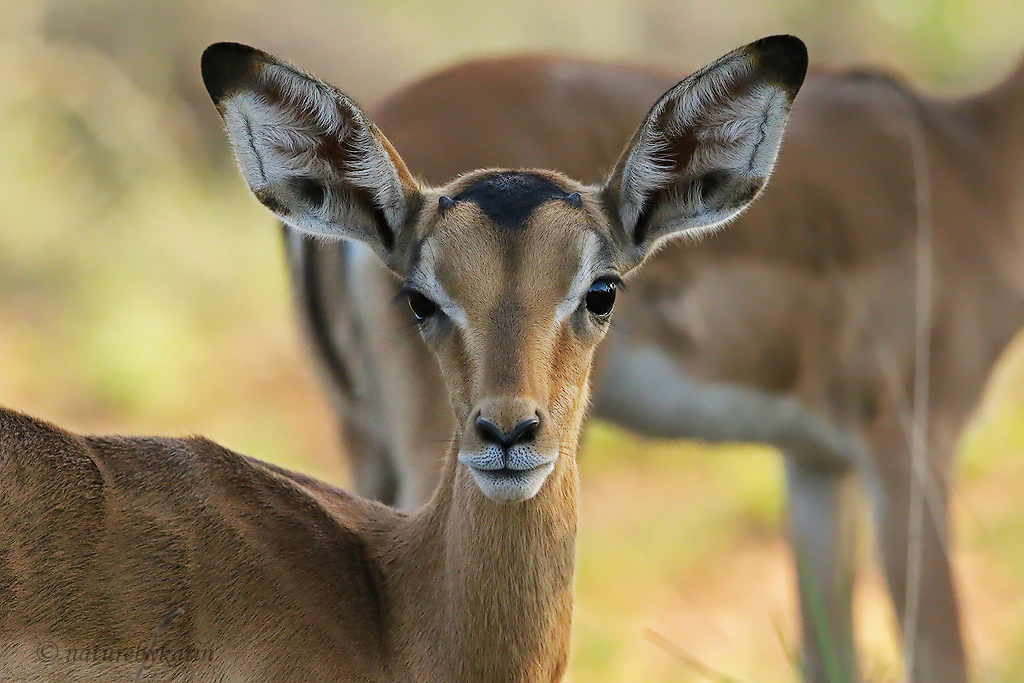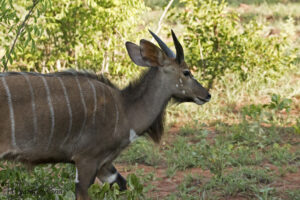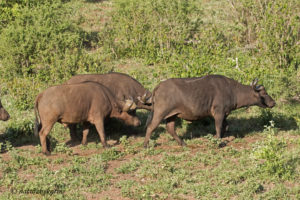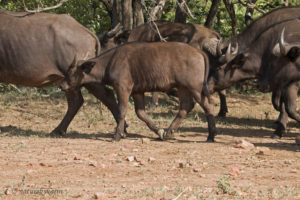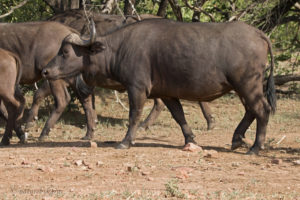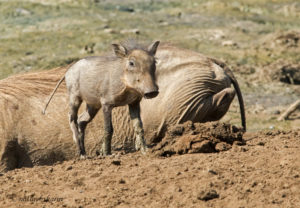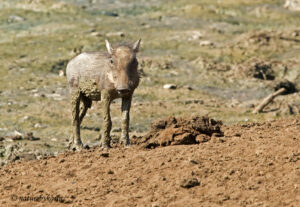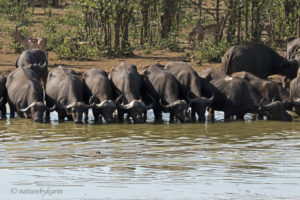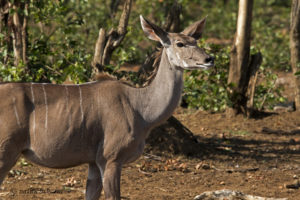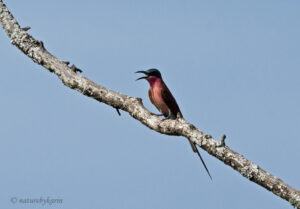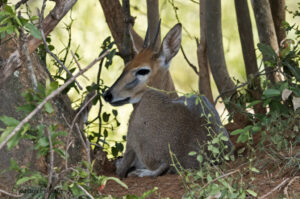Monday
I was very excited about my second visit to Punda Maria rest camp. I was going to spend 4 nights in this camp, and was hoping to really get to know this part of Kruger.
When a day starts like this, you know it will be a good one!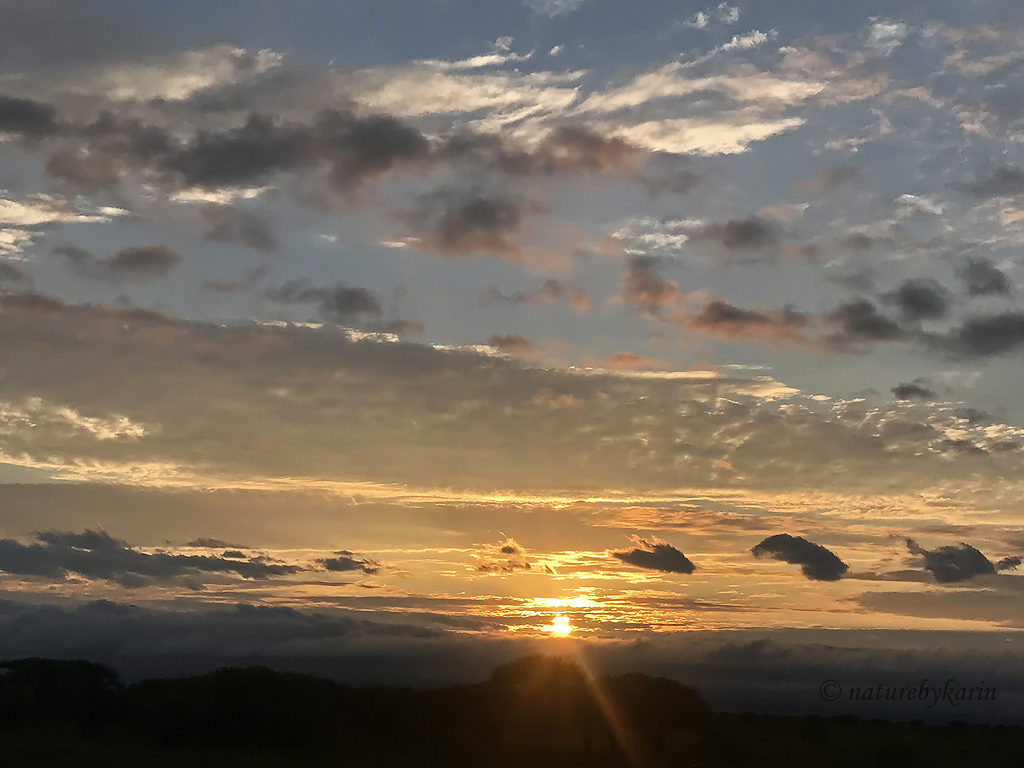
I arrived on Monday to somewhat overcast weather. I experienced the well known shiver down my spine as I drove through the gates – what would I see and experience?
Shortly after entering the gates I saw a small herd of zebras. Birds popped up all over the place I saw Red-breasted swallows, Violet-backed Starlings and a Broad-billed Roller in the distance shortly after entering the gate. In the short drive to the Tulumela waterhole I saw a whole bunch of birds –
Green Pigeon –
Southern Ground Hornbills –
My only Martial Eagle of the trip –
I was also happy to see a Jacobin Cuckoo –
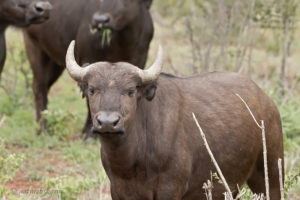 Just before the turn off to Punda I came across a herd of buffalo with both species of Oxpeckers keeping them company. I was a bit early for check in, so I went to spend some time at the hide. This waterhole had continuous activity throughout my visit, and some rather exciting sightings as well! This morning there were buffalo, Nyalas, Kudus and Zebras at the waterhole.
Just before the turn off to Punda I came across a herd of buffalo with both species of Oxpeckers keeping them company. I was a bit early for check in, so I went to spend some time at the hide. This waterhole had continuous activity throughout my visit, and some rather exciting sightings as well! This morning there were buffalo, Nyalas, Kudus and Zebras at the waterhole.
By the time I went to check in at about 13h00, I had already listed 40 species in my first 2 hours in the Park.
As I was walking back from reception, I noticed a guy with binoculars, and strolled over to have a chat. I was hoping to find the Pytillias and Guineafowls. He gave me good news about the latter, but not so good news about the former. While chatting to him a Willow Warbler and Paradise Flycatcher came to drink water at the little bird bath.
While I was settling in at my bungalow, the same guy came to ask if I would be interested in going on the sunset drive to look for the Pennant-winged Nightjar. I wanted to take this trip in November specifically for the nightjar, but I was not able to. I thought that by January I would be too late to see the bird in it’s feathered glory, and I told the guy this. He confirmed that people had seen the nightjar 4 days earlier. And he explained that the sunset drive required a minimum of 2 people, he was the only one so far, and if it is just the two of us, we can focus on finding the bird. I considered my rubber arm twisted and confirmed that I would go on the sunset drive.
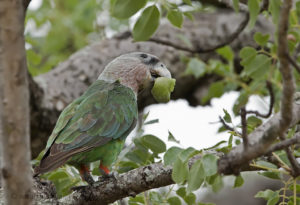 I went for a short drive on the Mahoni loop. I had barely left the camp when I saw my first lifer of the trip – Grey-headed parrots. There was a whole flock of them in big tree next to the road.
I went for a short drive on the Mahoni loop. I had barely left the camp when I saw my first lifer of the trip – Grey-headed parrots. There was a whole flock of them in big tree next to the road.
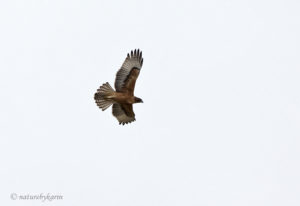 There was also a young African Hawk Eagle flying overhead. Other notables include Dark-chanting Goshawk, a young Wahlberg’s eagle still on the nest, Emerald-spotted Wood dove White-crested Helmetshrikes and Cinnamon Breasted Buntings.
There was also a young African Hawk Eagle flying overhead. Other notables include Dark-chanting Goshawk, a young Wahlberg’s eagle still on the nest, Emerald-spotted Wood dove White-crested Helmetshrikes and Cinnamon Breasted Buntings.
 I saw a Drongo posing next to the road and decided to take a photo of it. But I was completely distracted by other black birds a little further back – Rets’s Helmetshrikes. I have only seen these birds once before, and they were high on my wish list for this trip, so I was completely thrilled!
I saw a Drongo posing next to the road and decided to take a photo of it. But I was completely distracted by other black birds a little further back – Rets’s Helmetshrikes. I have only seen these birds once before, and they were high on my wish list for this trip, so I was completely thrilled!
This Red-backed shrike posed nicely.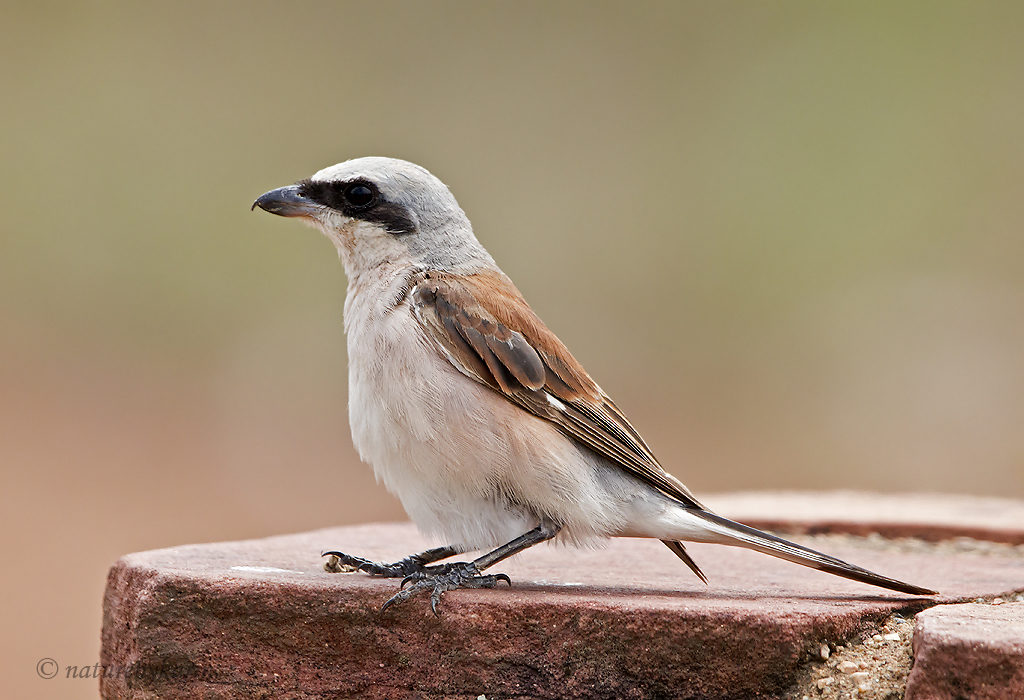
It wasn’t all about the birds – I did take some time to enjoy the mammals as well!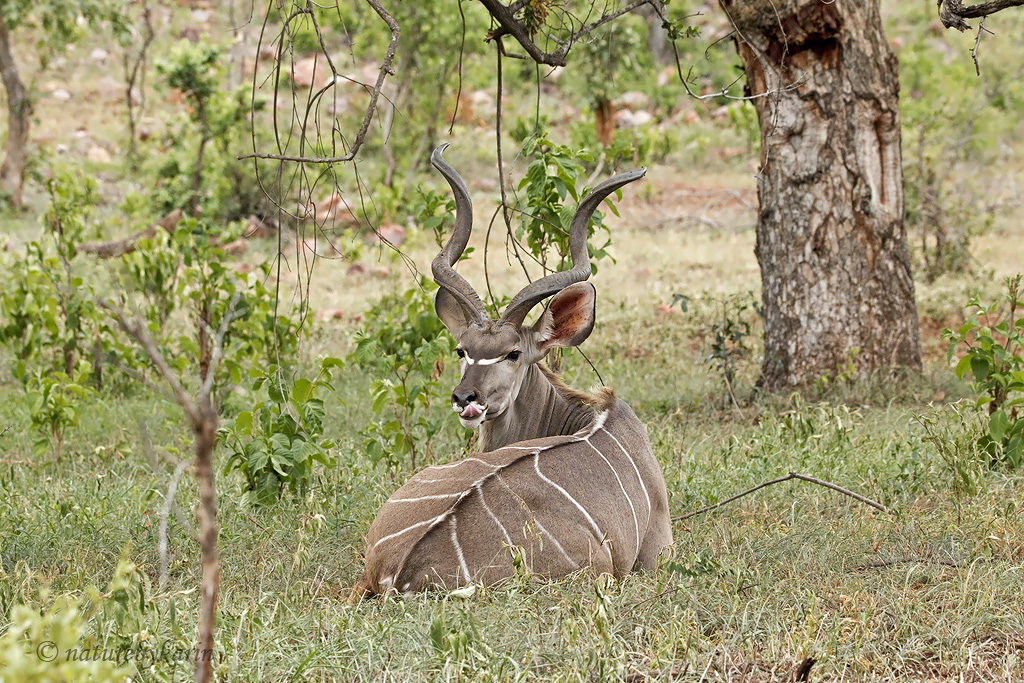
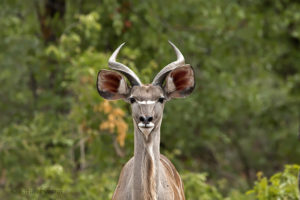
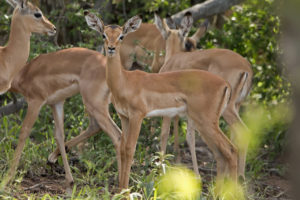
While waiting for the sunset drive to start, I was able to add Collared Sunbird, Marabou and a Yellow-bellied Greenbul to my list.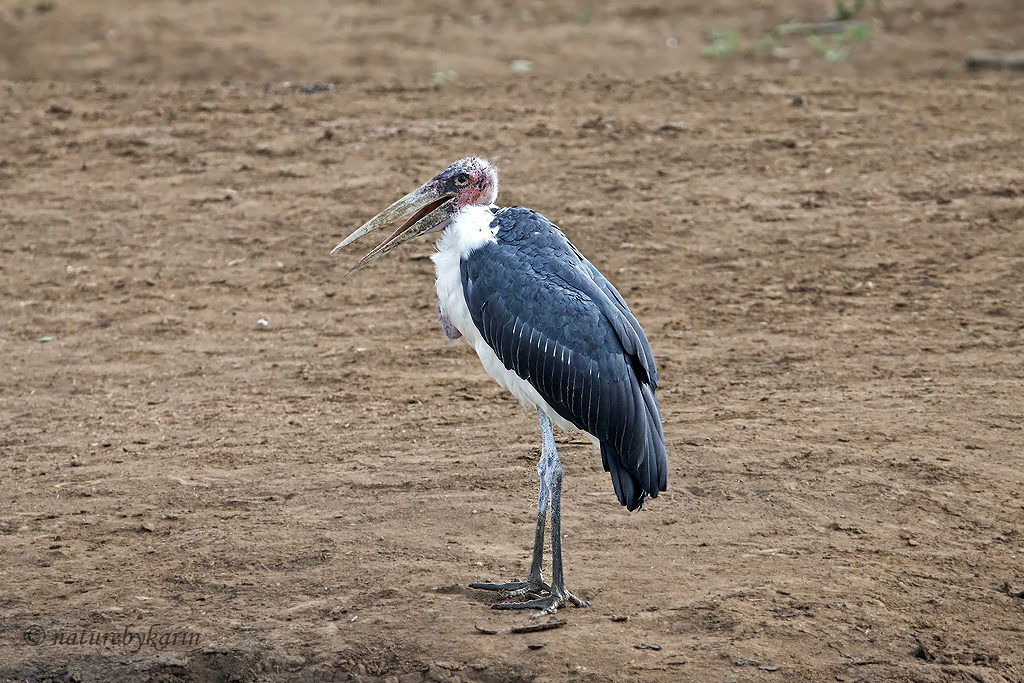
I also saw this beautiful butterfly.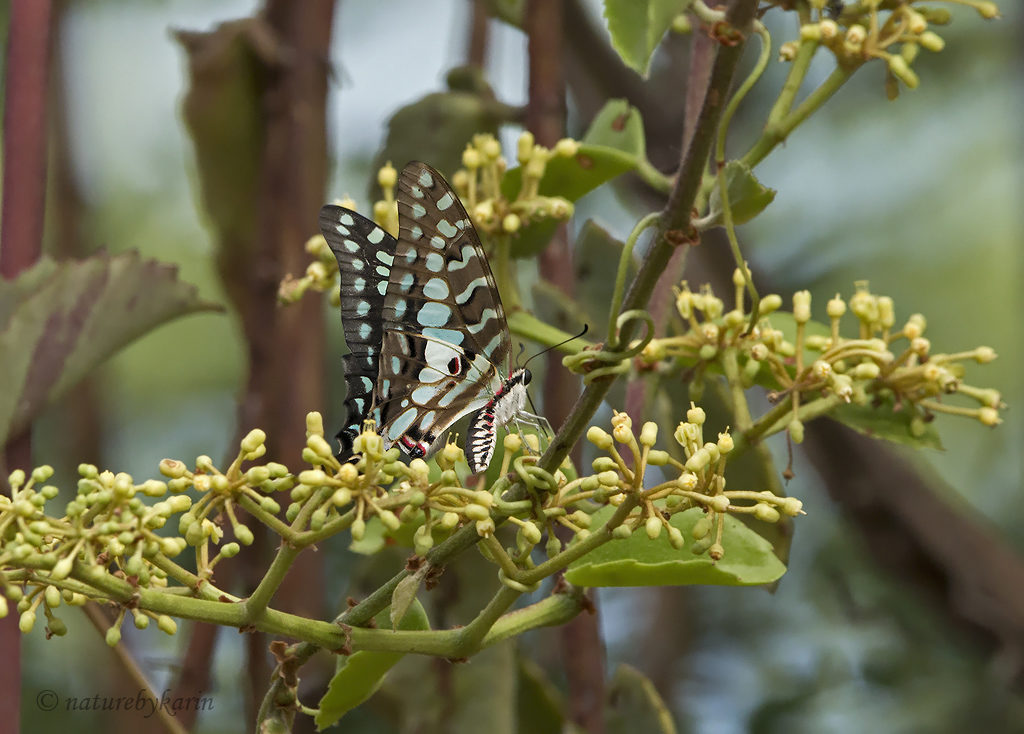
Some of the mammals we saw on the sunset drive include Nyalas, Buffalo, Kudus, Duikers and a Dwarf Mongoose.
We also saw a Sharpe’s Grysbok, also a species I have not seen in a while.
We drove on the Mahonie loop in a clock-wise direction. I spotted 2 large birds on the top of a tree right at the top of the Mountain. Inspection through the binoculars confirmed a pair of African Hawk-eagles.
Then we saw a flash of a kingfisher with a very specific electric shade of blue – a Grey-headed Kingfisher. Fortunately we found it (or a different bird) a little distance further.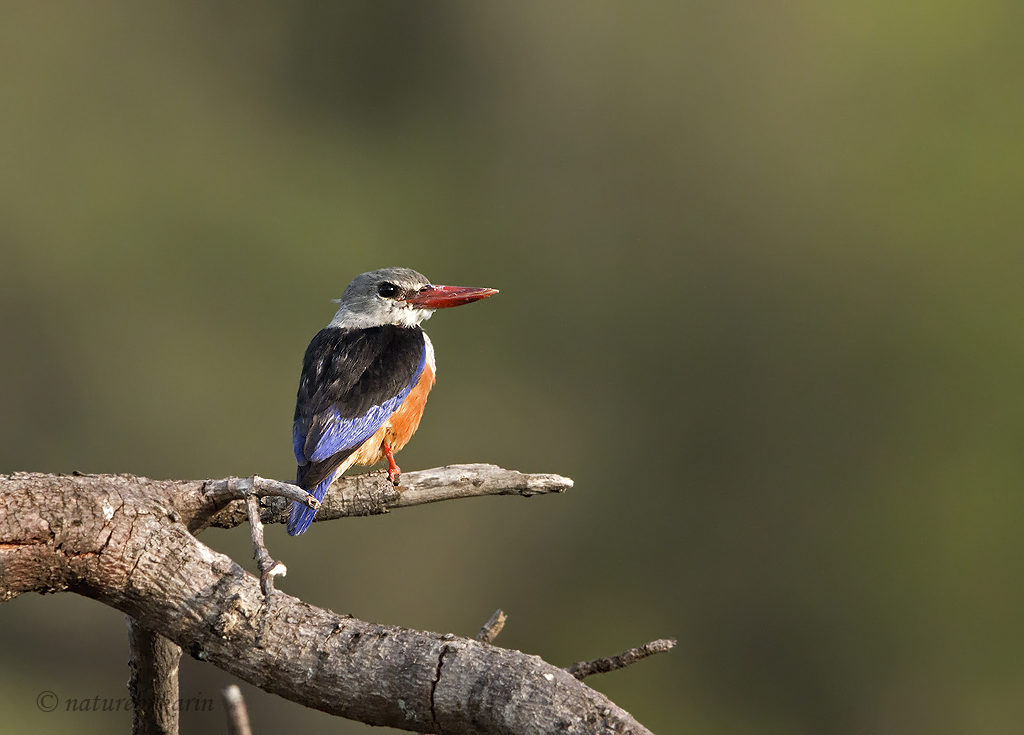
There were also a few Southern Carmine Bee-eaters and Mosque Swallows in a tree nearby.
Eventually we arrived at the spot where the nightjars were seen a few days earlier. An ellie was browsing on the spot where the guide wanted to park, but after a few minutes he moved off. I am always amazed at how quickly these giants can disappear.
We waited for sunset and the nightjars. I don’t know how to describe that moment. We were in a spot in the African Bush where people don’t normally go. The bush was green, the sky was blue, and all that we could hear were the sounds of the Park. It was so perfect, and I just wanted it to last forever.
The sun disappeared, and it was getting dark. But no nightjar. We waited and waited. Then 5 seconds happened that will stay in my memory forever – a male Pennant-winged nightjar with pennants flew across the darkening sky towards the west. It happened so quickly, but it still took my breath away. We waited to see if it would come back, but nothing. The guide suggested we drive to the other spot where they could be found. As we got to the truck, 3 male birds flew behind the truck – 1 male with pennants, but he disappeared quickly, and 2 males without pennants. These 2 stayed a bit longer and performed beautifully, flying within arm’s length of us. I could not get any photos of the birds, but it will be a memory that will stay with me forever.
On the way back to camp we saw many Springhares, or Krugerroos as I will now call them. I was scanning the trees in the hope of seeing some owls but only found a sleepy Tawny eagle. This completed my day total of 78 species for the first 8 hours in the Park.
Just before we reached camp, we saw one of the cutest things I have ever seen – a Scrub hare with 2 little babies! It was the perfect end to the perfect sunset drive!
We arrived back in camp much later than we were supposed to, but fortunately there was no night drive. I bought a take-away sandwich from the restaurant and then went to spend some time in the hide. An ellie came to drink. The perfect end to an exceptional day.
Tuesday
I had arranged with Samson from Limpopo Birding to be my guide on the Tuesday. On my way to the gate to meet him, I spotted a little raptor in a tree in the distance. The photos were not great, but clear enough to confirm that it was an Eurasian Hobby – my third lifer for the trip!
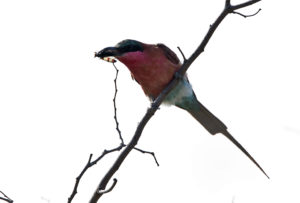 We drove north via the S60. The road was extremely corrugated and unpleasant to drive. New birds for the trip included Green-winged Pytillias, Golden-breasted Buntings, Natal and Crested Francolins. As we drove, we saw all the birds you would expect to see as well as Mosque Swallows, an African Hoopoo, a Black-shouldered Kite and Carmine Bee-eaters.
We drove north via the S60. The road was extremely corrugated and unpleasant to drive. New birds for the trip included Green-winged Pytillias, Golden-breasted Buntings, Natal and Crested Francolins. As we drove, we saw all the birds you would expect to see as well as Mosque Swallows, an African Hoopoo, a Black-shouldered Kite and Carmine Bee-eaters.
I also saw my first European Roller for the trip and a Village Indigobird.
We finally reached the Levubu bridge. There was loads of activity. We spotted a Thick-billed Roller in a tree, and a Great Egret buzzed the tower. A number of birds could be heard, including 3 Cuckoo species – Red-chested, Black and Diederik cuckoos.
We also saw 3 Kingfisher species – Pied, Woodland and Brown-hooded. A couple of Wooly-necked storks were browsing upstream.
But the real stars were the raptors. We had excellent sightings of Yellow-billed Kites and Wahlberg’s eagles.
 An African Harrier-hawk joined the party as well. And then the magnificent African Fish Eagle did a low fly-by.
An African Harrier-hawk joined the party as well. And then the magnificent African Fish Eagle did a low fly-by.
He circled a few times over our heads. He is such an iconic bird and one I always associate with the Park.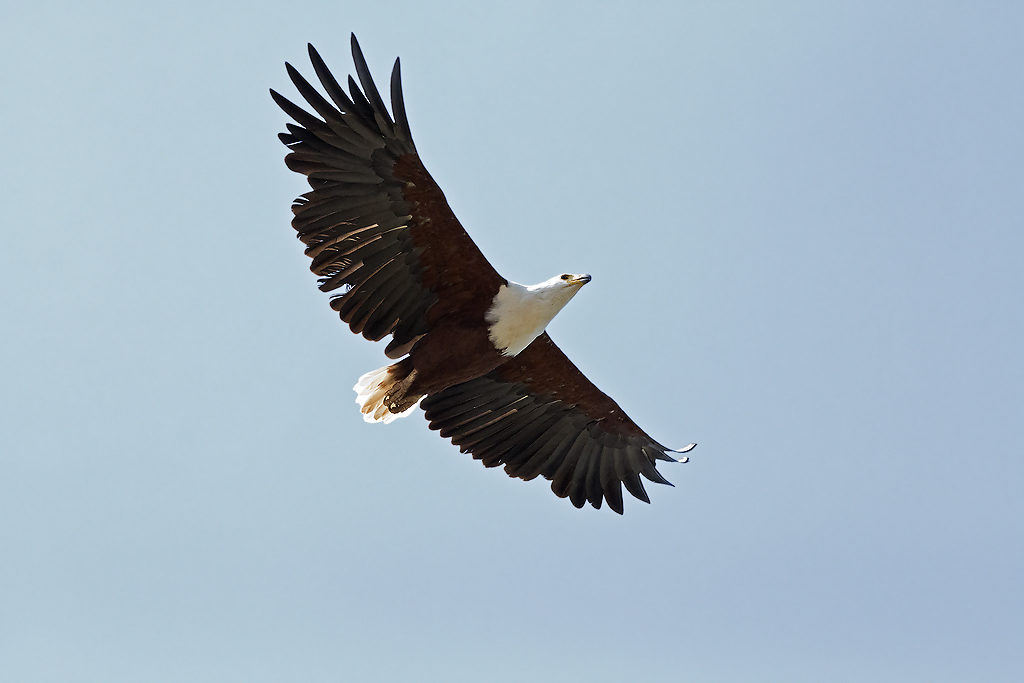
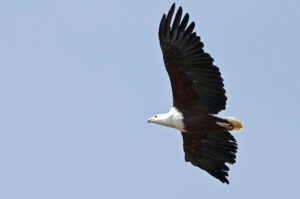
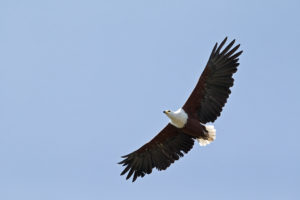
Unfortunately, there were no Spinetails. I was rather disappointed as I really wanted to see these birds.
Samson knew of a spot where we could possible find Racket-tailed Rollers, and we continued on in the direction of the Pafuri Gate. Notable birds included Buffalo weavers, another Jacobin Cuckoo and a Brown Snake Eagle.
Despite our best efforts, we could not locate the rollers and turned around. We saw some Red-headed weavers in a boabab tree.
There was a small pool of water just before the bridge, and here we found a Hamerkop. We stopped on the bridge again to see if the Spinetails had arrived, but they were still not there. We did see a Brown-throated Martin and a Spur-winged goose – my first for Kruger. Samson called me over excitedly – a Little Sparrowhawk was trying to catch Swifts. He then perched in the tree for a few seconds before hiding in the foliage until matters had calmed down some and he could try again.
We arrived at the picnic site and had something to eat and drink. None of the birds I had been hoping to find there were around, and I was rather disappointed.
I was however able to add a Tawny-flanked Prinia and Grey heron to the trip list.
There were birds all along the river as we drove to Crooks Corner. I’ve never seen as many White-crowned Lapwings as I did on this trip. We also saw another pair of African Hawk-eagles. And then I got another lifer in the form of a Tropical Boubou. Sadly I could not get a photo as he would not sit still, but I did have some excellent views of this bird.
Another new bird for my Kruger list was White Storks. There was a large flock just before we reached Crook’s corner. I stopped counting when I reached 50.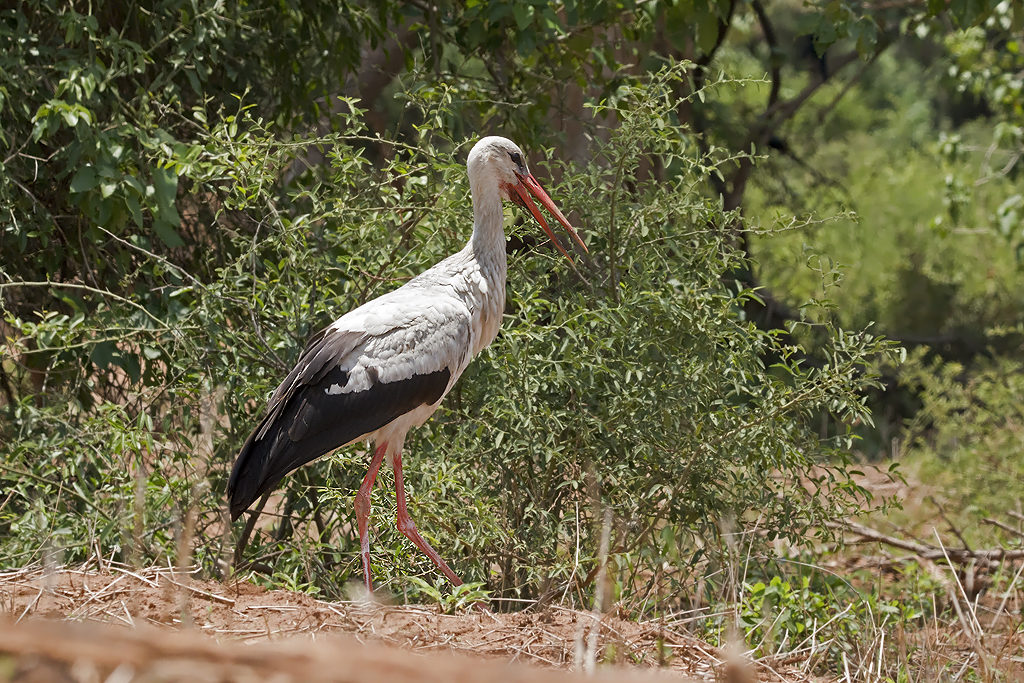
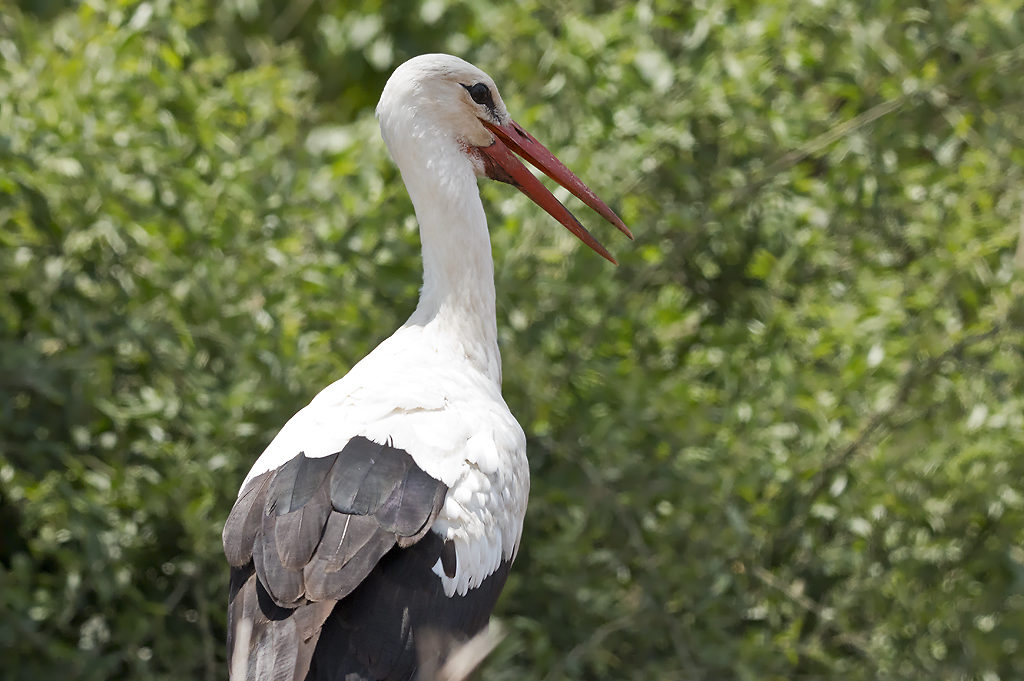
Two Saddle-billed storks flew parallel to the river. We would catch up with them at crooks. Retz’s helmetshrikes were flitting about in the trees and a Yellow-billed stork was relaxing in the shallows.
Samson asked me at the start of the day which birds I would like to see. I had a pre-prepared list of lifers, obviously, but also some “nice to see” birds. These are birds that would not be lifers, but are birds that I have not seen for a while, and would like to see again. As we approached one of the huge leafy trees next to the river, he told me to stop and look up. In the tree above the car was a beautiful Trumpeter Hornbill. What a fabulous find! I’ve not seen one since May 2015, and I really wanted to see another one. This bird sat quietly, allowing us to take many photos.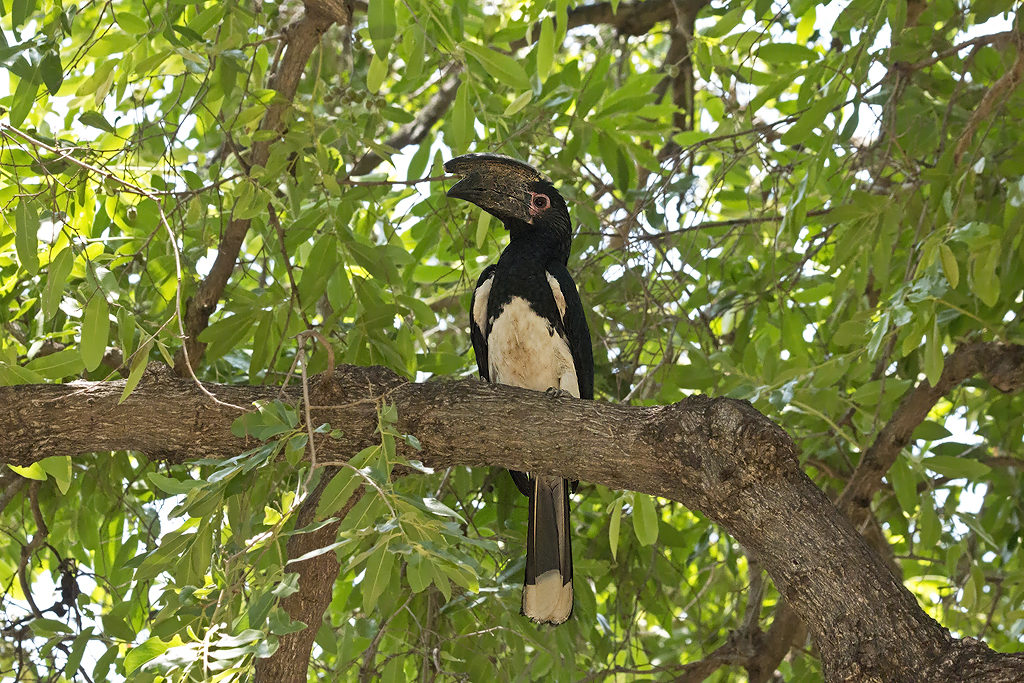
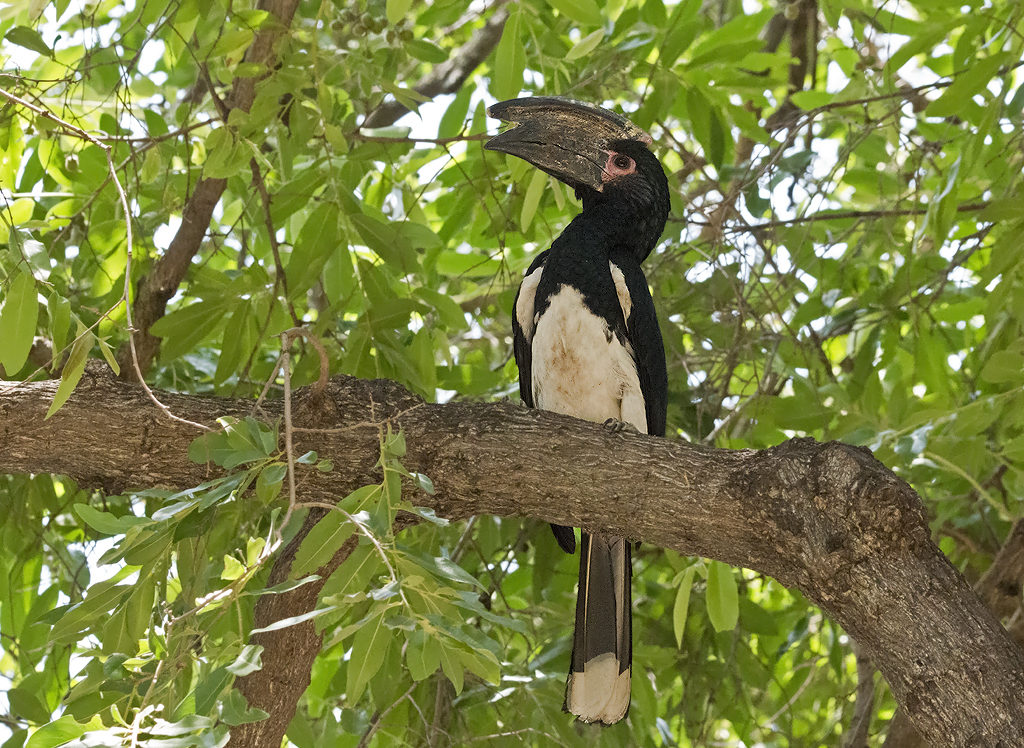
We saw a few more birds along the way to Crooks, but the most exquisite highlight of my trip waited for us at Crooks. We ran into the guy from the sunset drive at the Picnic site, and he told us about a little bird in a tree at Crooks. We found the tree, and Samson started searching. And searching. I would inch the car forward, backwards, we would both strain our necks, and then he saw it. I could not. I turned the car around. The Pel’s Fishing Owl shook its feathers and suddenly I could see it. I took some blurry photos with shaky hands.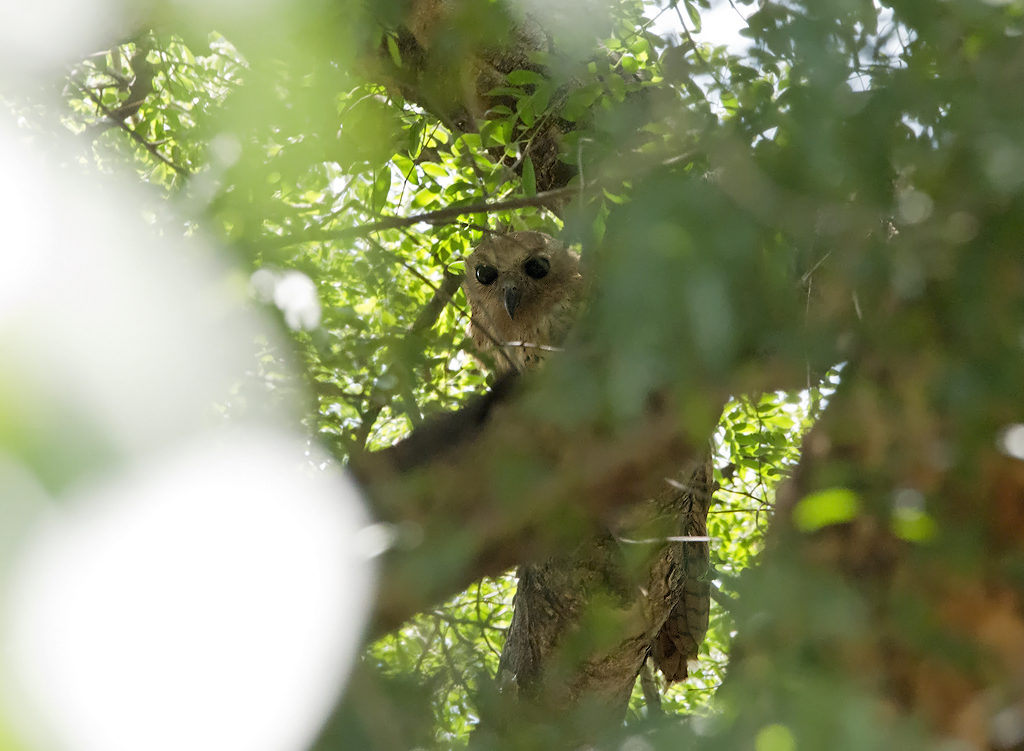
Then the bird obliged and moved to another branch, and we could get decent photos.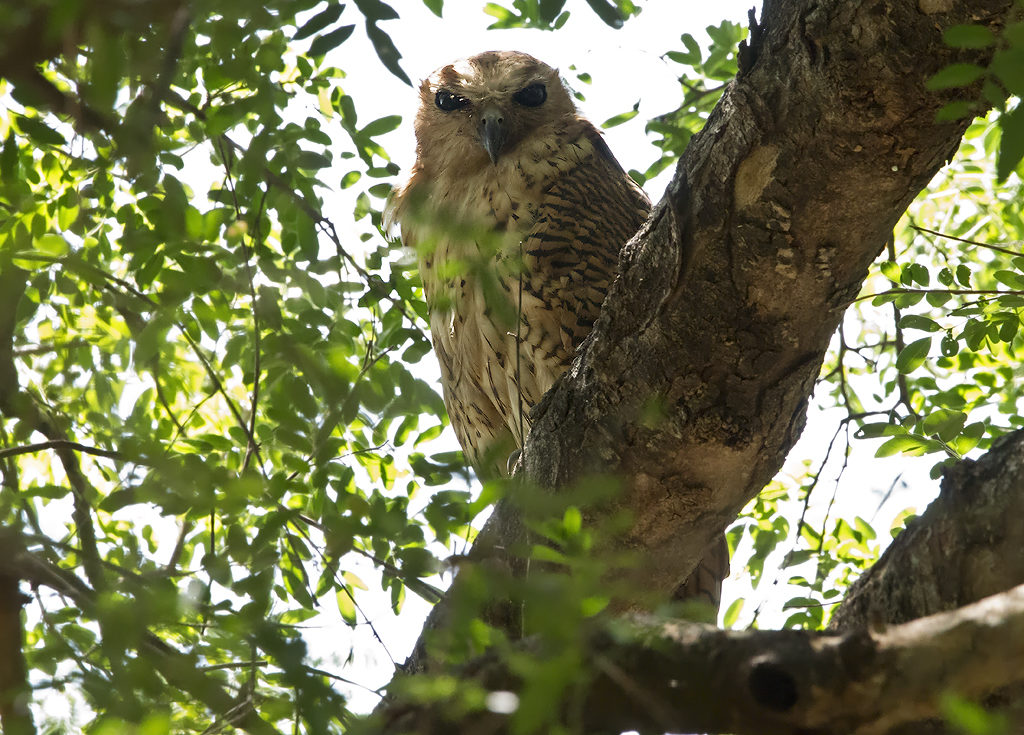

After a while it decided enough photos had been taken, and it flew off. Until recently I thought it was smaller than the Verreaux’s Eagle Owl. But they are very similar in size, both body size and wingspan. And when he flew off, we got a very good view of that impressive wingspan.
I don’t quite know how to describe how I felt. If someone told me I could choose only one creature to see in the 4 days I was there, they would guarantee it, but I would see nothing else, the Pel’s Fishing Owl would probably be my choice.
When we got out of the car at the Crooks look out point, Samson and I high fived each other. I don’t know whose smile was the widest. It was lifer 507 for me, and Samson’s second ever sighting of this magnificent bird. I don’t think I would have found the owl in that tree without his help, and I will be forever grateful for his help in finding it!
Once we calmed down a little, we looked around Crooks Corner a bit. The two Saddle-billed Storks from earlier were foraging around.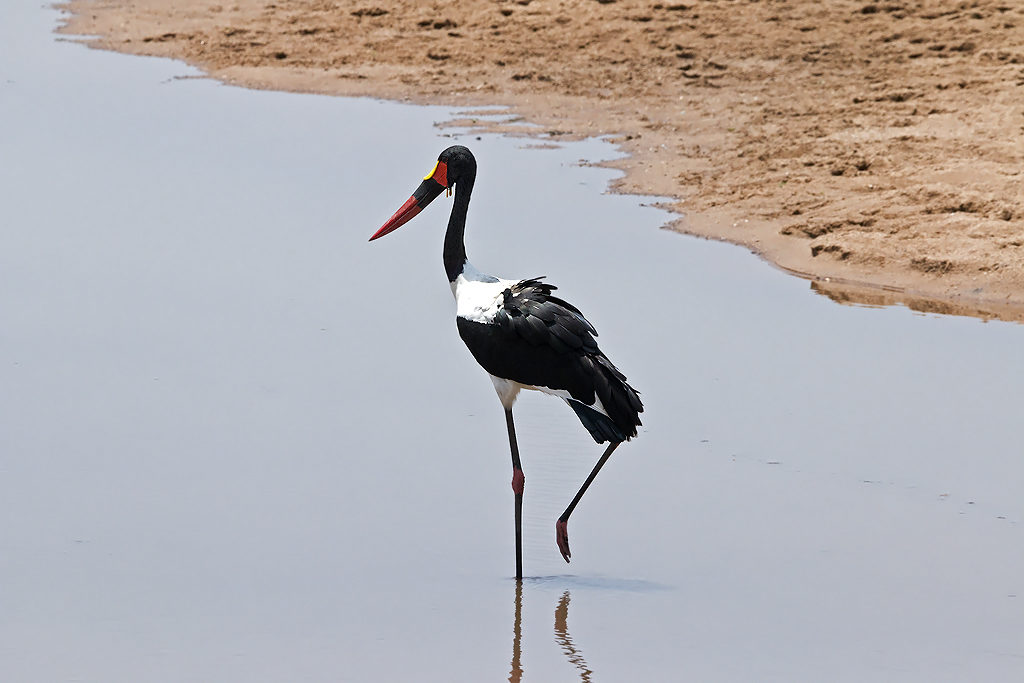
A crocodile was smiling at us.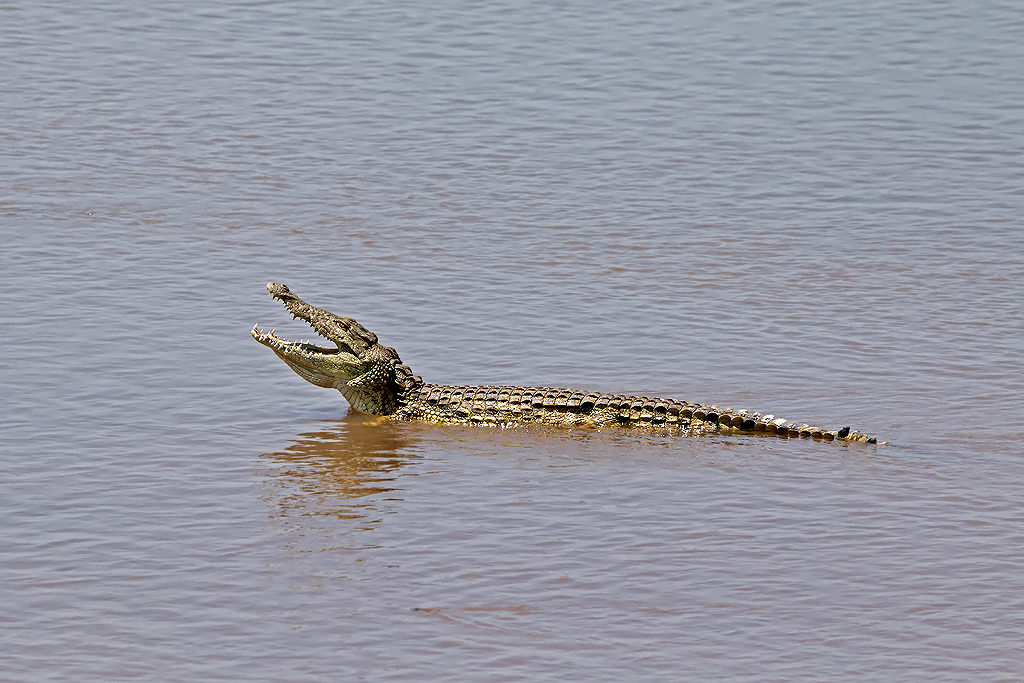
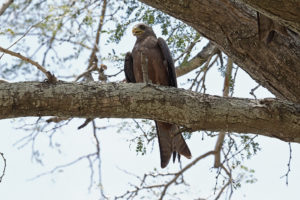 A fish Eagle flew overhead. There were two Yellow-billed Kites. We also spotted a Twinspot Batis and a Yellow-bellied Apalis. There was another African-harrier Hawk in the distance.
A fish Eagle flew overhead. There were two Yellow-billed Kites. We also spotted a Twinspot Batis and a Yellow-bellied Apalis. There was another African-harrier Hawk in the distance.
We took the same road back, but it was a lot quieter this time. There were still some White storks around, and we spotted a Western Cattle Egret in the river.
We also found a family of warthogs. There were a couple of adult females and a bunch of piglets.
We found it interesting that the piglets suckled from more than one female – we saw one suckle from one female and then go to another to suckle. It seems sharing is in fact caring!
Throughout the trip I heard Woodland Kingfishers all over the place. It really sounded as if there was one in every tree, but spotting them was not so easy!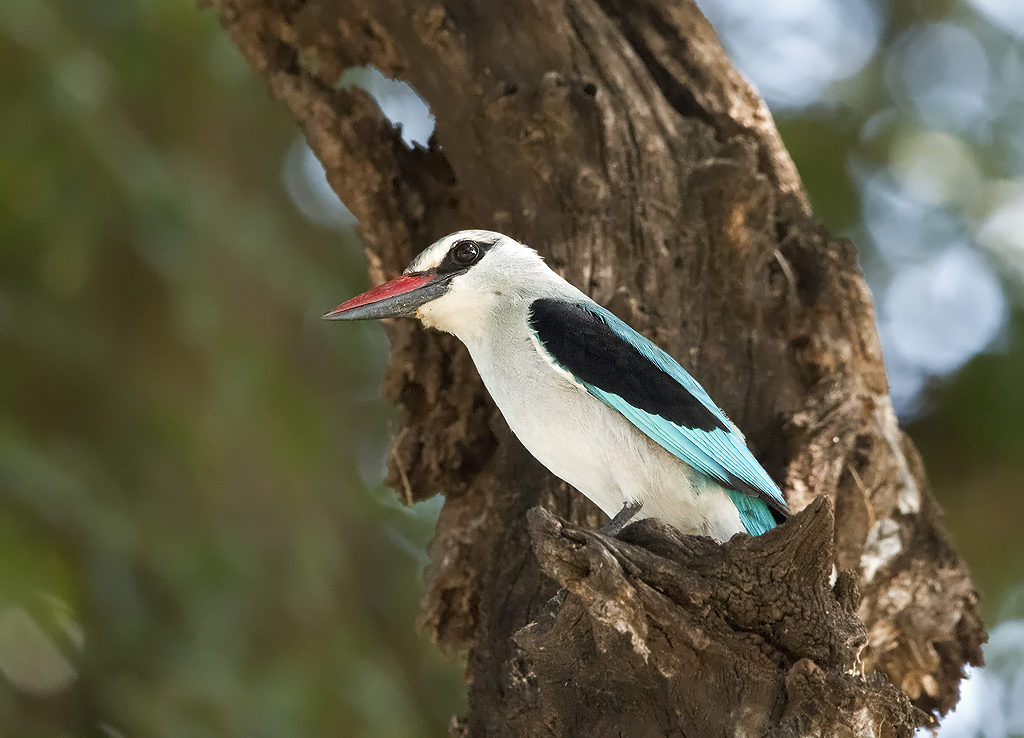
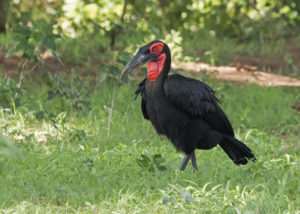 We did not stop at the picnic site again but drove to the Nyala road. Birding-wise it was very quiet, but we had great views of Black-crowned Tchagras and two Southern Ground Hornbills.
We did not stop at the picnic site again but drove to the Nyala road. Birding-wise it was very quiet, but we had great views of Black-crowned Tchagras and two Southern Ground Hornbills.
Back on the tar we stopped at the pools of water next to the road again.
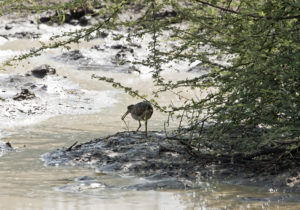 Earlier there were no birds, but this time there was more action. We saw a male and female Diderick Cuckoo (up to now I’ve only heard them). We also saw a Namaqua dove, and the had the wonderful surprise of a Painted Snipe under a bush.
Earlier there were no birds, but this time there was more action. We saw a male and female Diderick Cuckoo (up to now I’ve only heard them). We also saw a Namaqua dove, and the had the wonderful surprise of a Painted Snipe under a bush.
The road back was extremely quiet, but the noisy call of a Red-crested Korhaan alerted us to it’s presence, and we saw a Steppe Buzzard as well.
Close to the camp turn off Samson heard the Stierling’s wren’warbler caling, but despite his best efforts, the bird would not show itself. Before I dropped him off we saw another Brown Snake Eagle.
Birding was challenging throughout the day, but with Samson’s help we crossed the 100 species seen milestone for the day. I also added 51 species to the trip list, bringing my trip total to 129.
On the way back to camp I saw more Carmine Bee-eaters.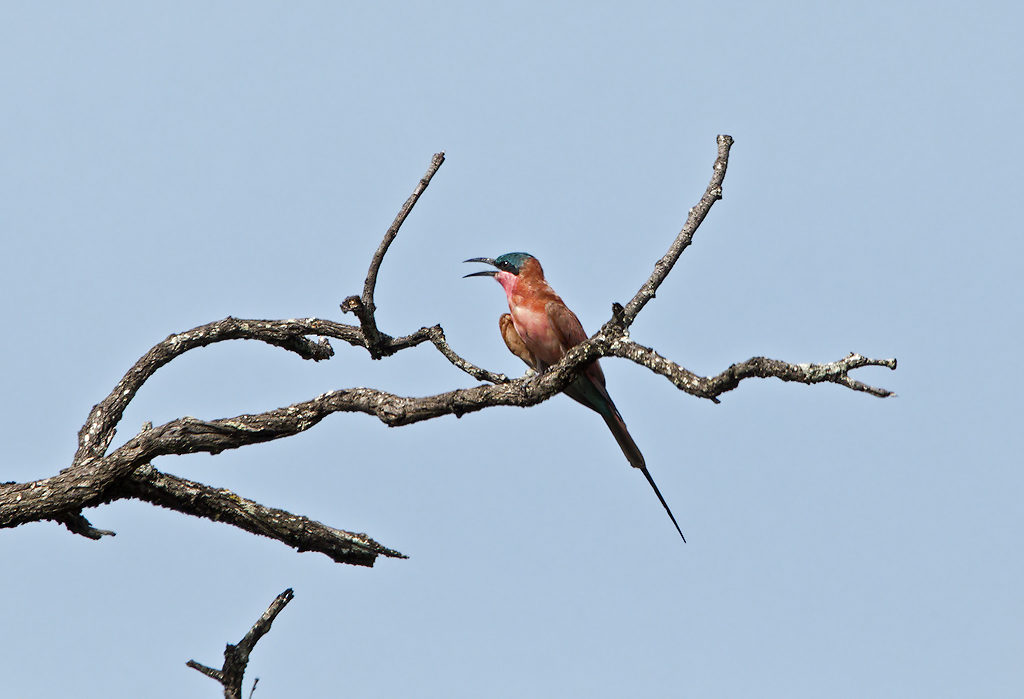
There was also a cute young zebra and another family of warthogs.
The last species I added to my day list actually happened when I was back in camp after I dropped Samson. I was sitting on a bench in the braai area with a cold beer, reviewing my day list when I heard the Red-chested cuckoo call above my head. I’ve heard these birds call in Kruger a few times now, but never managed to see it. I looked up and was thrilled when I saw it and could add it to my day and Kruger list.
I ended the day at the waterhole again. There were some ellies and buffalo, and again it was a good end to a great day!
Wednesday
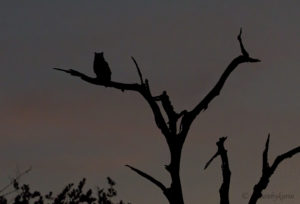 The plan for Wednesday was to drive to Shingwedzi. I left camp a little while after the gates opened. It was still quite dark. Shortly after turning left at the intersection, I saw my only owl of the trip. I like the silhouette of the Verreaux’s Eagle Owl against the pre-dawn sky. The drongo did not like the owl, and the owl soon got the message and flew off.
The plan for Wednesday was to drive to Shingwedzi. I left camp a little while after the gates opened. It was still quite dark. Shortly after turning left at the intersection, I saw my only owl of the trip. I like the silhouette of the Verreaux’s Eagle Owl against the pre-dawn sky. The drongo did not like the owl, and the owl soon got the message and flew off.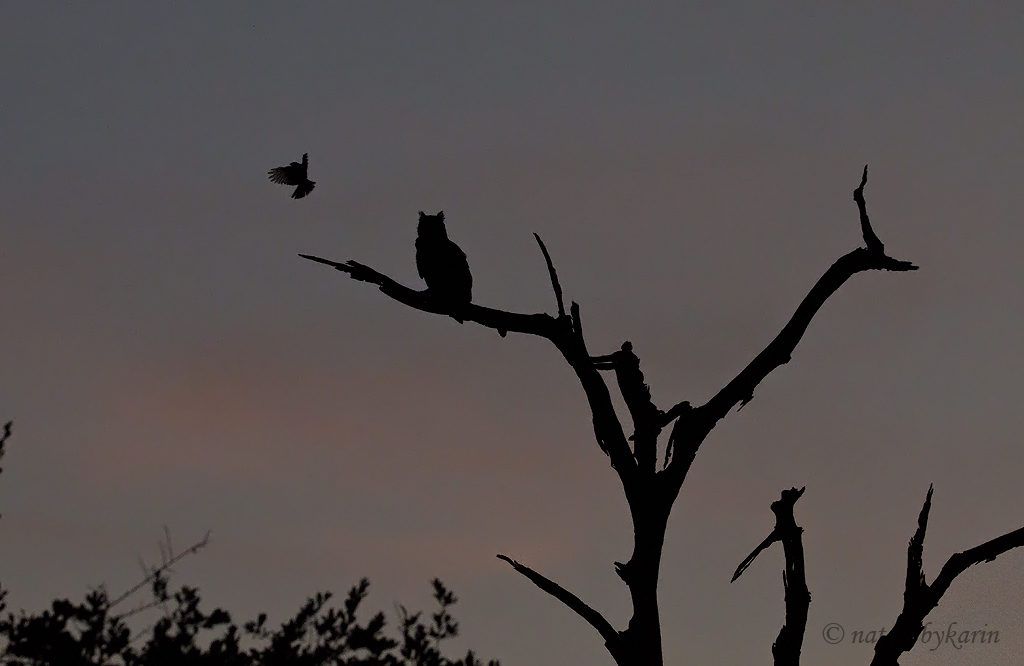
I drove The S58 for the first time. There were lots of birds along the way – all the usual birds you could expect, but also Pytillias, Brubrus, a Jacobin cuckoo and Buffalo weavers. I could also hear both Klaas’ cuckoo and Red-chested cuckoos in the distance. I was also able to add a Spotted Flycatcher to the trip list. There were many Red-backed Shrikes and a curious Giraffe.
Back on the H 1-7 I saw a lone Double-banded sandgrouse male.
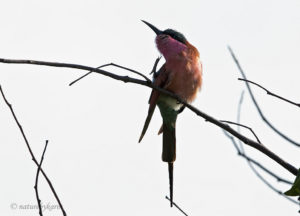 One of the things I loved most about visiting the Park this time of the year was the amount of Southern Carmine bee-eaters that I saw. On most previous visits I was either too late or too early for them. A little tree squirrel was foraging next to the road.
One of the things I loved most about visiting the Park this time of the year was the amount of Southern Carmine bee-eaters that I saw. On most previous visits I was either too late or too early for them. A little tree squirrel was foraging next to the road.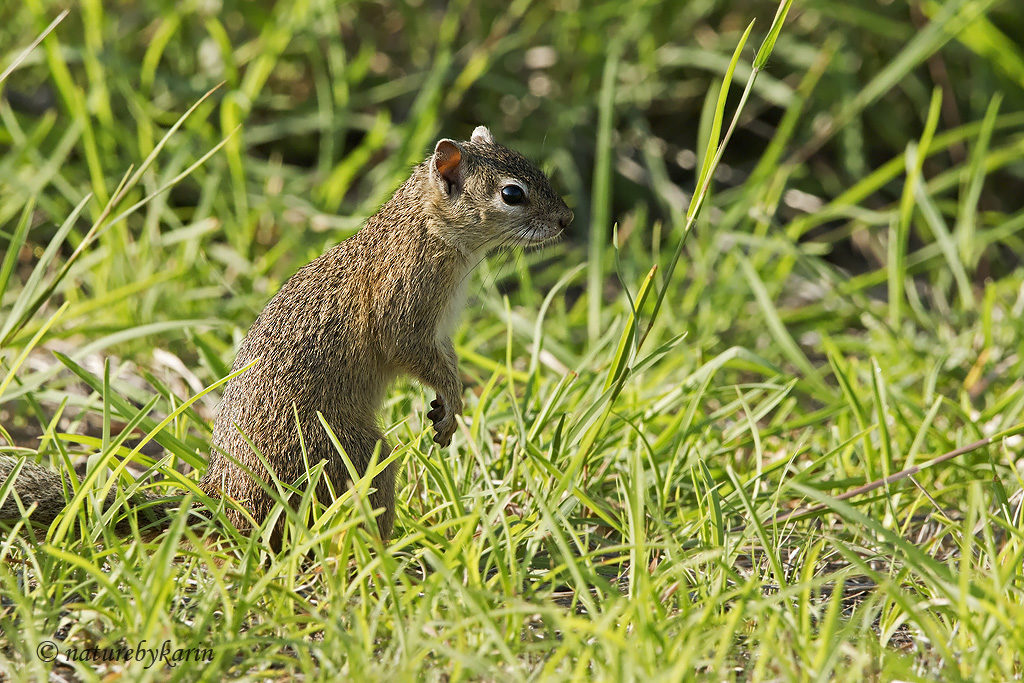
I stopped for coffee at the Babalala picnic site. It was so peaceful to have my coffee and rusks and just stare out over the plains. I heard a bird in the tree above me. Samson had explained to me that Woodland kingfishers have another call – this call sounds almost parrot-like. For a moment I thought parrot, but then I saw the Woodie and realised that was the bird that was making such a strange noise.
I saw some more White storks at the Boyela waterhole.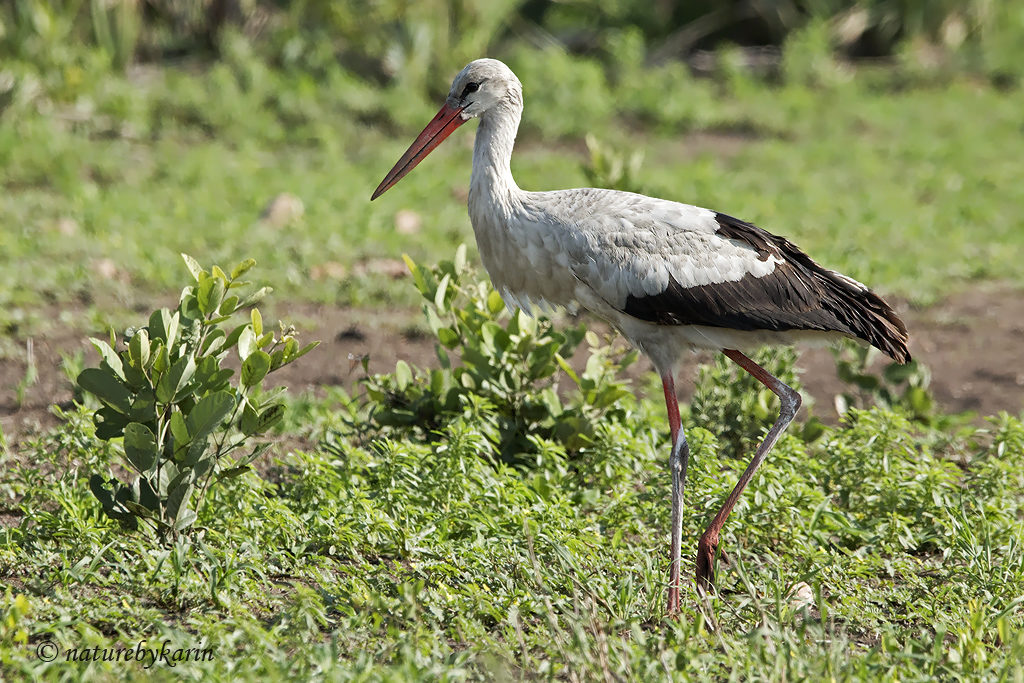
There were a couple of birds and animals on the way to Shingwedzi, but it was very quiet. I decided to enter Shingwedzi from the back via the causeway. There was a pretty Brown-hooded Kingfisher and European Roller.
At the river I found Marabou, Lapwings, a Grey heron and a Red-eye dove.
As I got out of the car at the shop, I heard a Glossy starling call from the tree next to my car. It made me look up, and that is when I spotted the Little Sparrowhawk in a tree not far from the car. If not for the Starling, I may have missed it. It looked like the Little Sparrowhawk was eating something.
There were a few birds in the river bed, most notably my only African Jacana sighting of the trip.
Another exciting sighting at Shingwedzi was that of a Lesser Honeyguide – a first for me in Kruger. Unfortunately I could not get a photo.
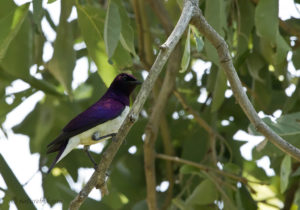 After I enjoyed a refreshing ice cream, I did the loop at the back of the camp as far as the Kanniedood hide. Some interesting birds that I saw include a Common Sandpiper, African Spoonbill, another Grey-headed Kingfisher, White-browed Robin-chat, Grey-headed sparrows and more Violet-backed Starlings.
After I enjoyed a refreshing ice cream, I did the loop at the back of the camp as far as the Kanniedood hide. Some interesting birds that I saw include a Common Sandpiper, African Spoonbill, another Grey-headed Kingfisher, White-browed Robin-chat, Grey-headed sparrows and more Violet-backed Starlings.
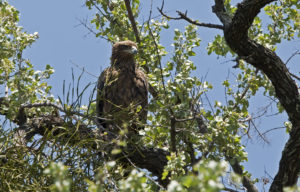 I drove through the camp, and just outside the gate there were more birds – Yellow-billed Kites, a Tawny Eagle, Saddle-billed Storks and Crested Barbet. I was also happy to add Goliath Heron to my trip list.
I drove through the camp, and just outside the gate there were more birds – Yellow-billed Kites, a Tawny Eagle, Saddle-billed Storks and Crested Barbet. I was also happy to add Goliath Heron to my trip list.
If I thought the road from Shingwedzi to the H13-1 turnoff was quiet in the morning, it was now worse. It was extremely hot. But it did look as if the area had some good rain the night before – I saw the lighting from the hide in Punda, and in the morning there were lots of puddles on the tar road.
A highlight was a flock of ostriches – previously I’ve only seen lone individuals, but now there were about 10 or so, in 2 groups on each side of the road.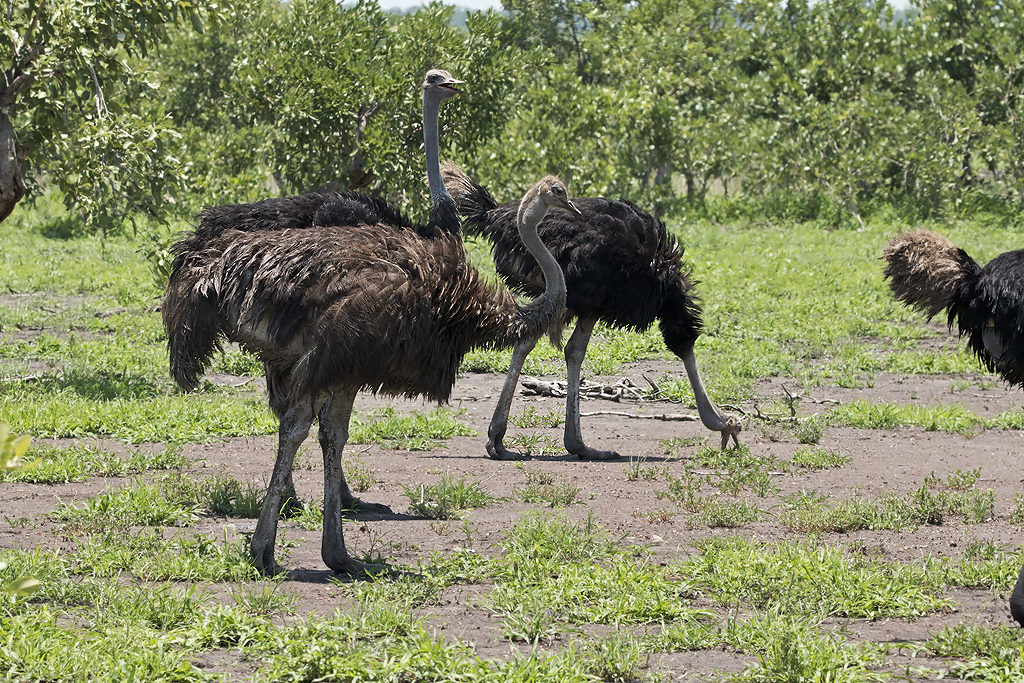
There was also a herd of buffaloes in one of the small water holes next to the road.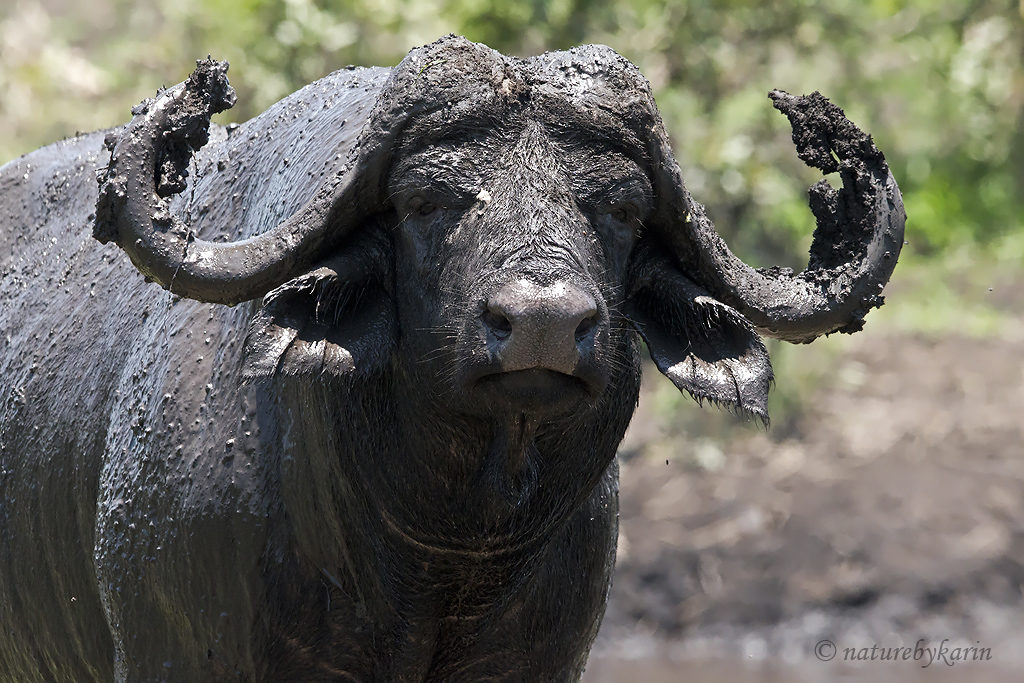
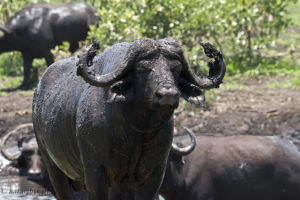
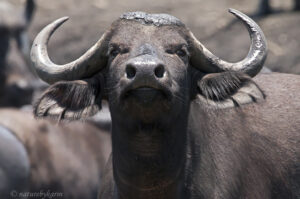
I spotted a Southern Ground Hornbill taking shelter from the heat in a tree.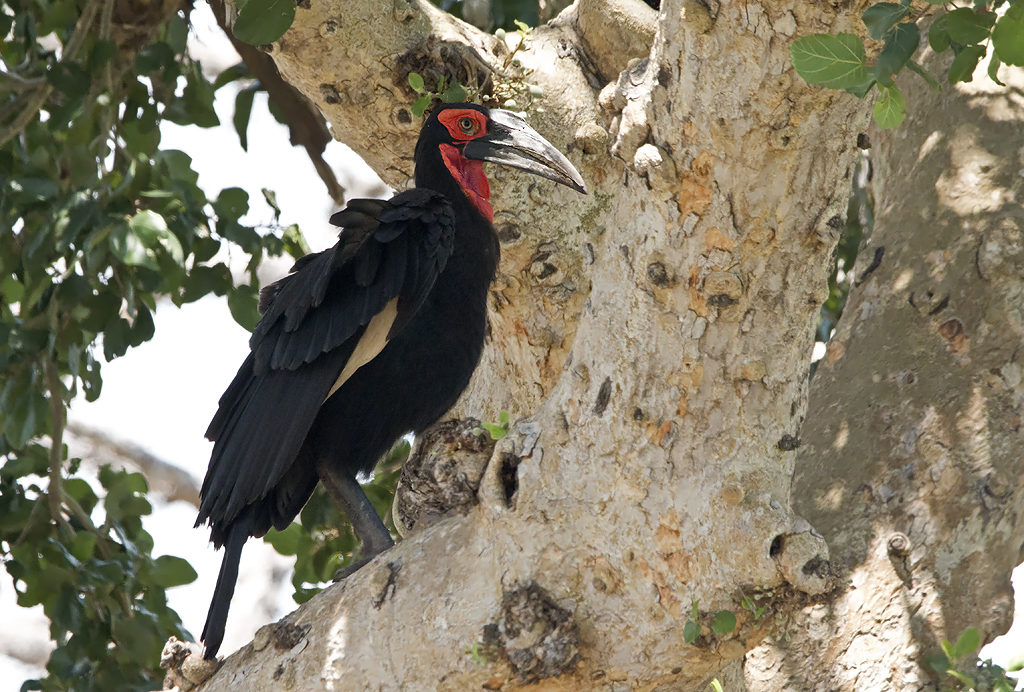
I came across a few elephants along the way.
Back in camp I went for a walk on the Flycatcher trail – I needed a leg stretch after the long drive, and I still had a very specific bird on my list to see. Within seconds I spotted the bird I wanted to see. The Crested guineafowls were resting under the bushes. I did some off-roading, and was able to get close to them. They really are comfortable around people. Again I had a huge smile on my face – I dipped on these birds on my previous Punda visit, and was really glad I could find them this time.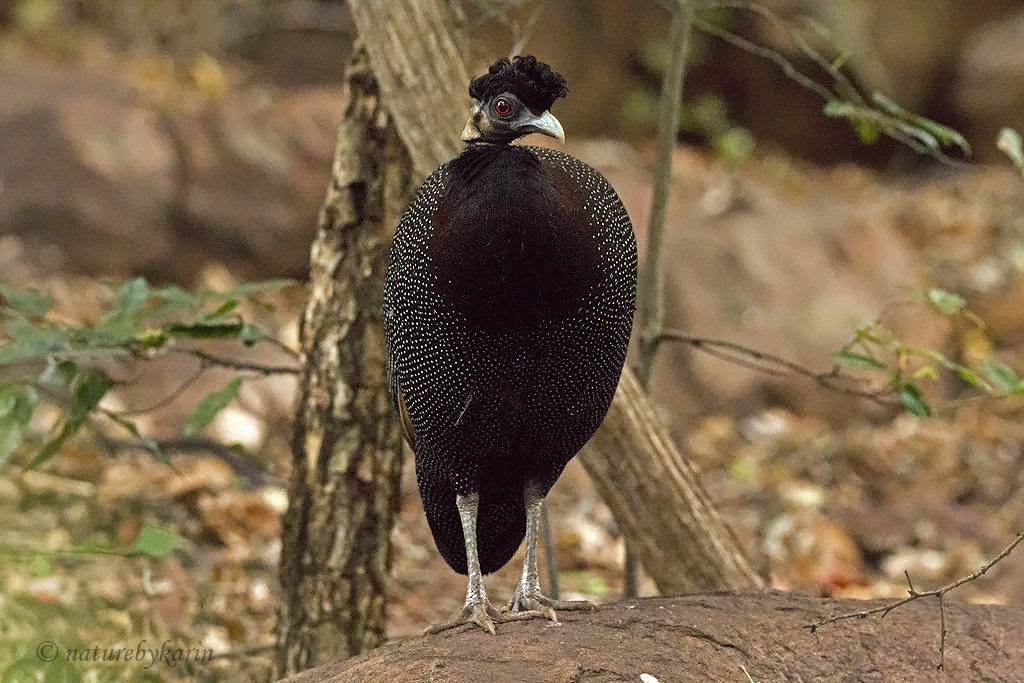
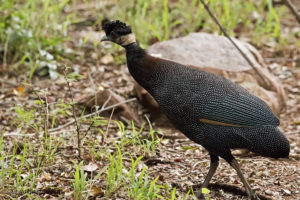
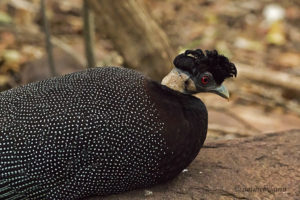
A Bushbuck was taking a rest in the shade as well.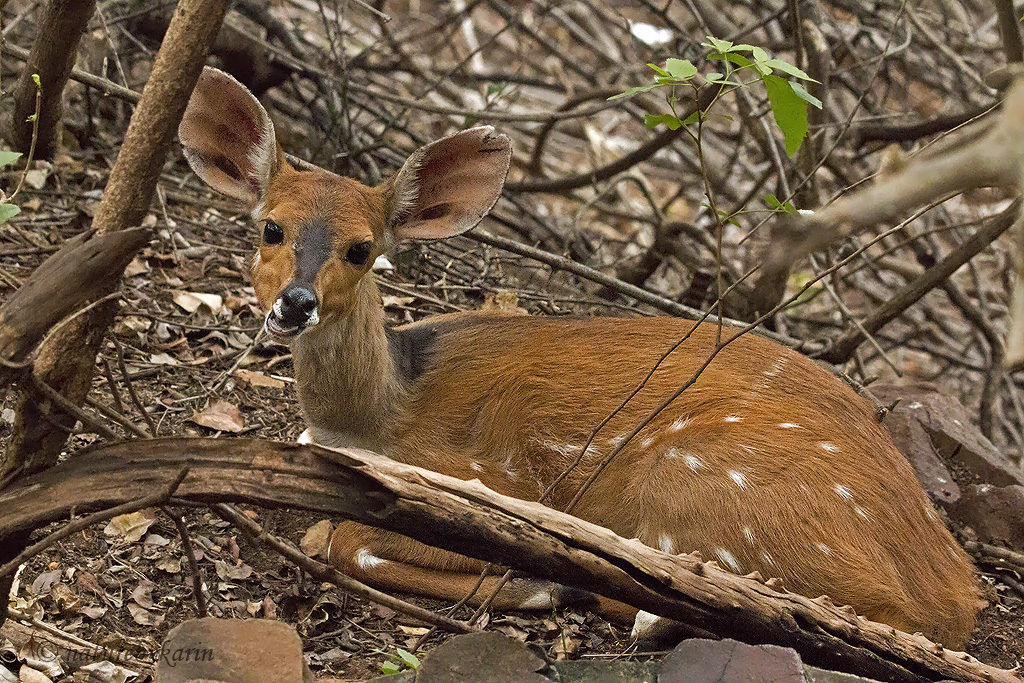
A family of Vervet monkeys was playing at the braai area.
After my walk I went for a drive on the Mahonie loop. I had the exciting find of a pair of Groundscraper Thrush in a tree near the first waterhole. I continued with sightings of Chinspot Batis, Red-backed Shrikes and White-throated Robin-chat. There was another White-browed Scrub-robin, and some White-backed Vultures in a tree.
It was overcast all of a sudden, and I desperately hoped it would rain as I was really struggling with the heat. About 2 drops fell, the temperature dropped from 39 to 36 degrees, and that was the end of that.
The rest of the Mahonie loop delivered more of the usuals- Violet-backed Starlings, Waxbills, Woodland kingfishers, Drongos, Golden-breasted Buntings and Wood-hoopoos. There were also some animals.
I love the innocence of the young impalas.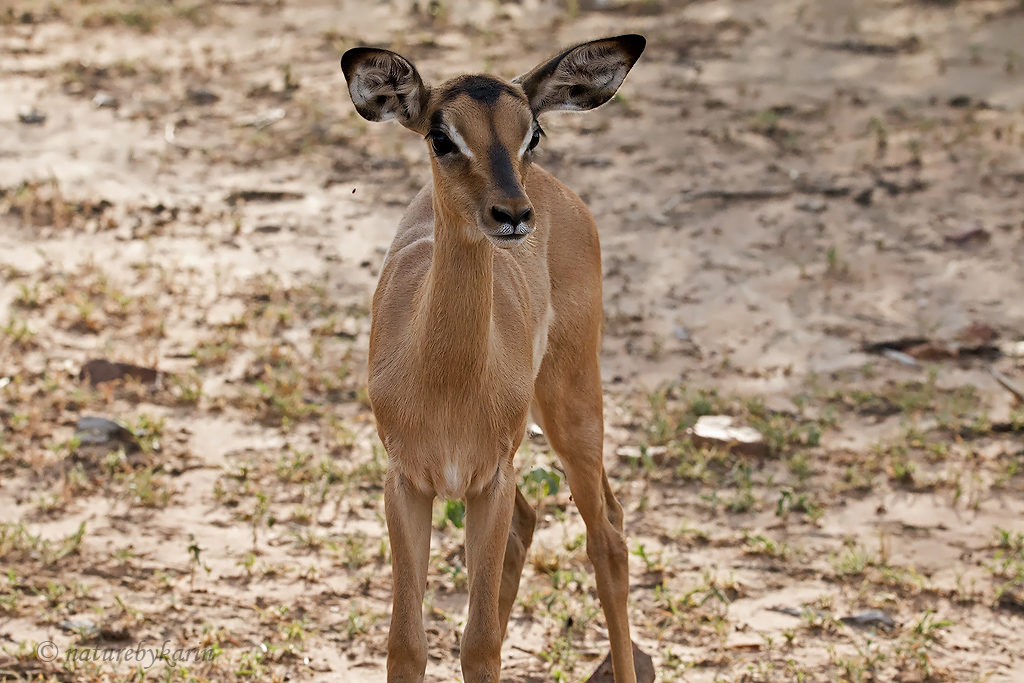
There were two young kudu bulls butting heads.
I always enjoy seeing Yellow-billed Oxpeckers.
I spent the last hours of the day at the hide. There was lots of activity. A herd of buffalo cam to drink.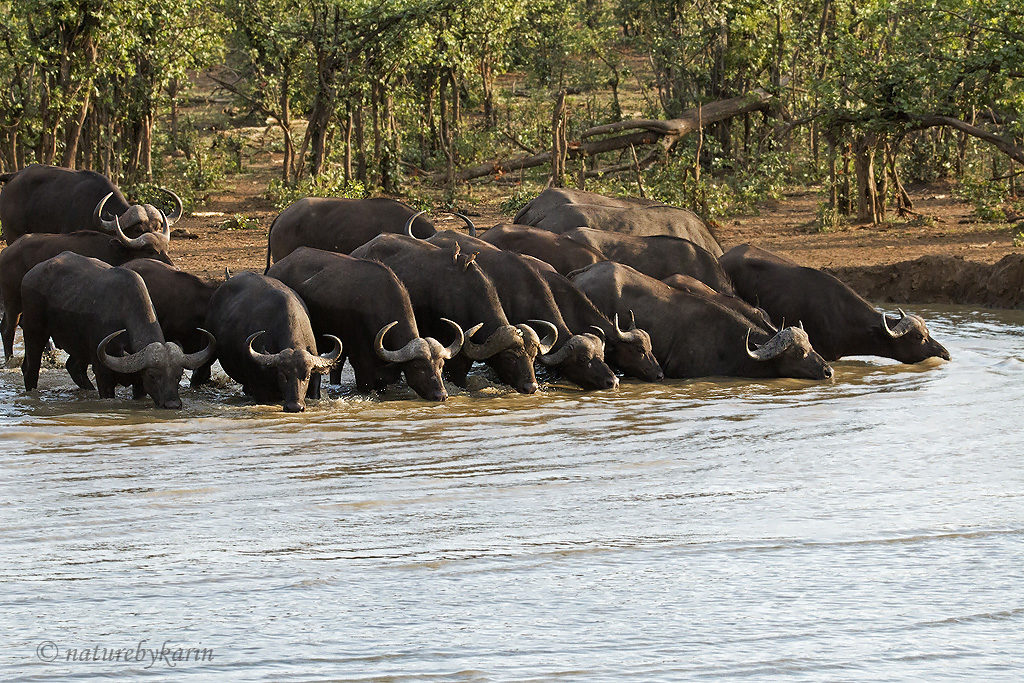
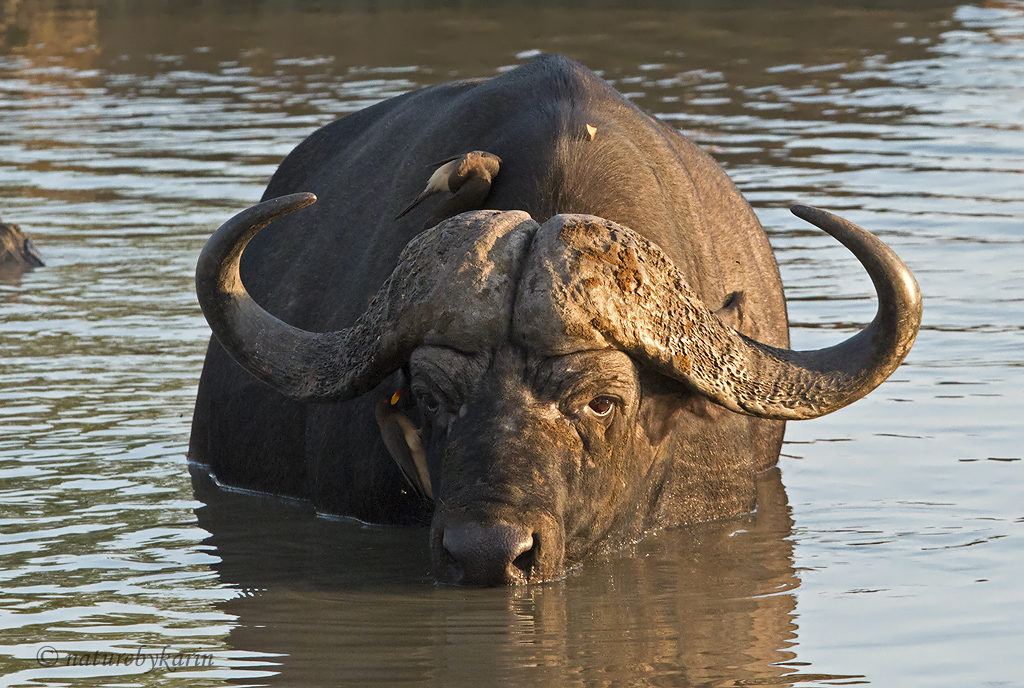
The buffalo crowd made the kudus a little nervous, but one enterprising youngster figured out how to get some water.
Some of the impalas followed his example.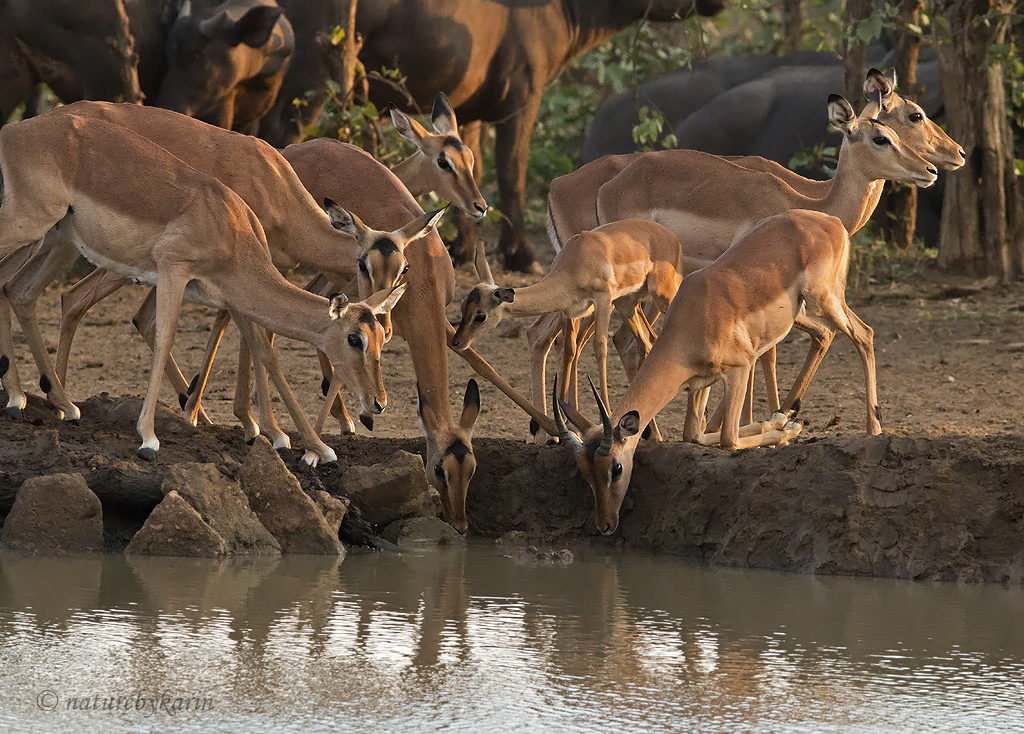
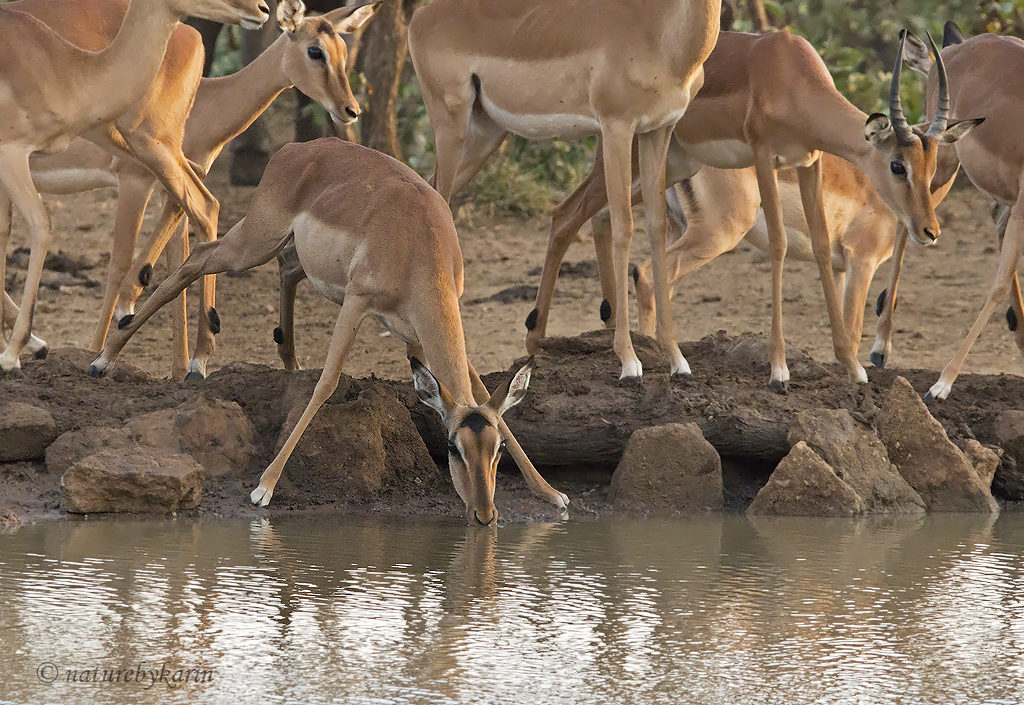
After dinner I went back to the hide. There were a few elephants. And then a special moment – a leopard came to drink water. It stayed at the water for a few minutes before disappearing into the darkness.
Thursday
I had not yet visited Klopperfontein and that was my first destination for the day. Once there I would decide where to go next. I wanted to be there really early, and I left camp not long after the gates opened. It was still very dark. I took out my flashlight with the intention of using it like a spotlight. Best decision ever! And the reason why I got to Klopperfontein much later than planned!
Minutes after taking out the flashlight, it shone on a young leopard right next to the road. Someone had mentioned that there was a female with 2 grown cubs in the area. I scanned the area with the flashlight and immediately saw the 2nd leopard a few meters behind the first leopard. Wonderful. I did manage to operate both the flashlight and the camera at the same time and took some photos in the dark.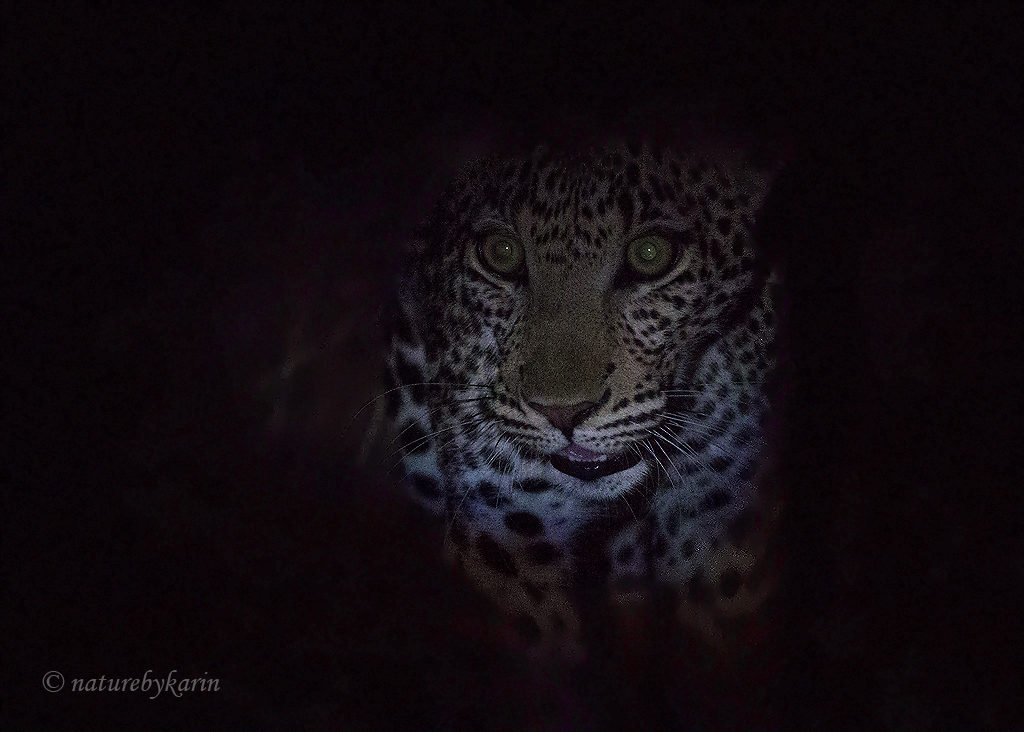
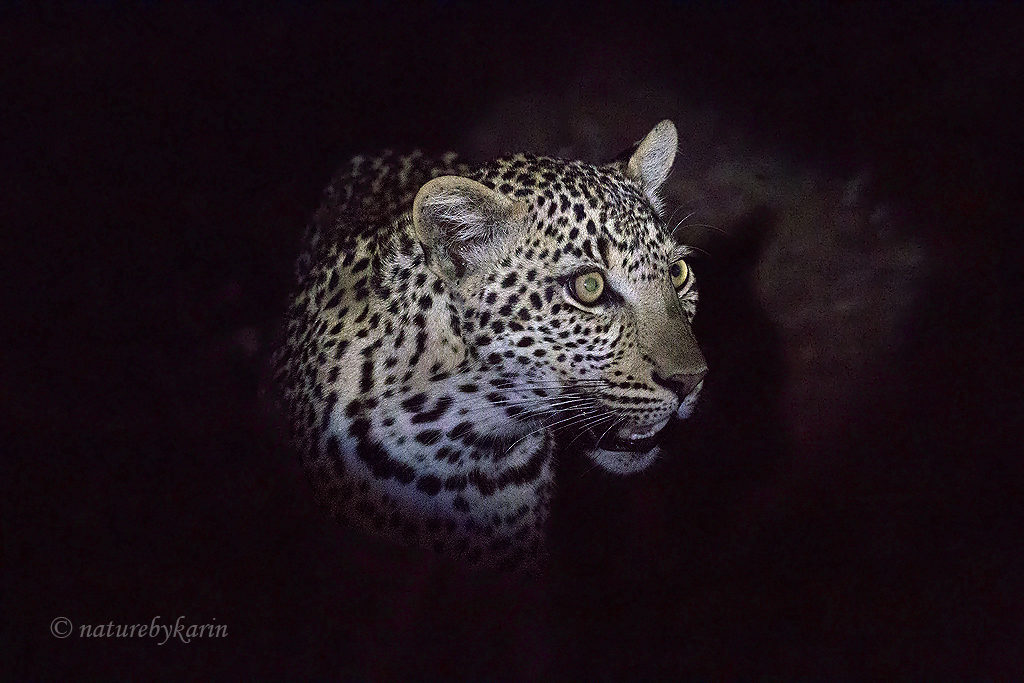
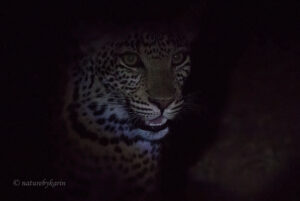
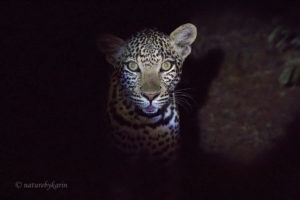
Both of them then crossed the road and went to lie down under a bush. The light was still terrible, but it was so great to see the two together!
I continued to take photos as the light improved, but unfortunately, they were only together in the low light conditions.
One other car arrived, but they did not stay long. I soon realised that the 2 leopards were not going to go anywhere, and I decided to wait for better light.
After a while the one leopard moved into the bushes and the other crossed the road again.
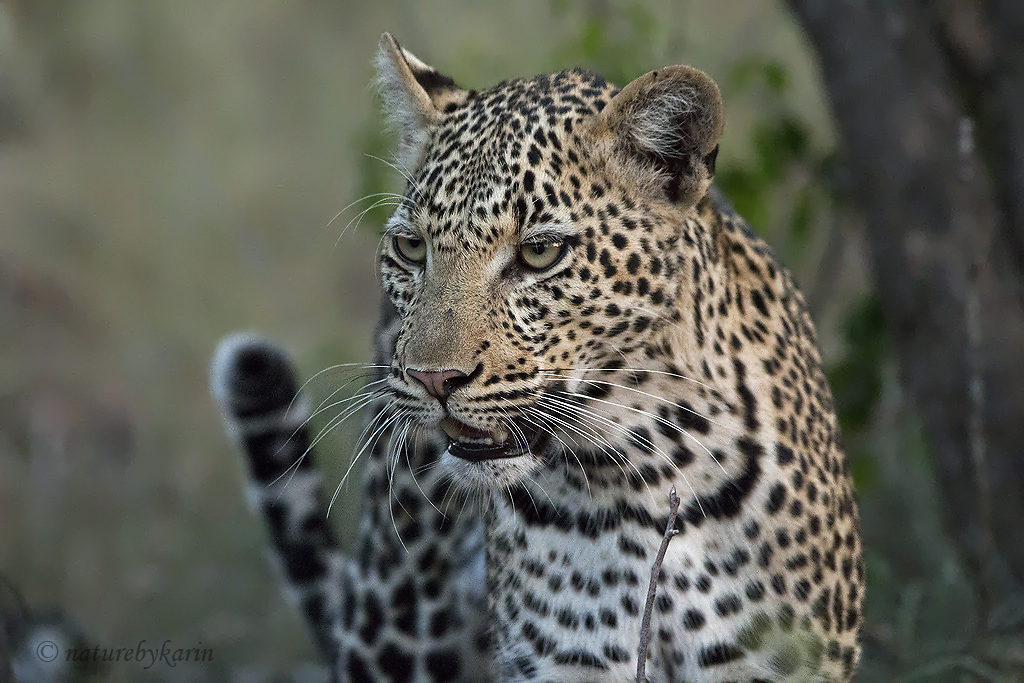
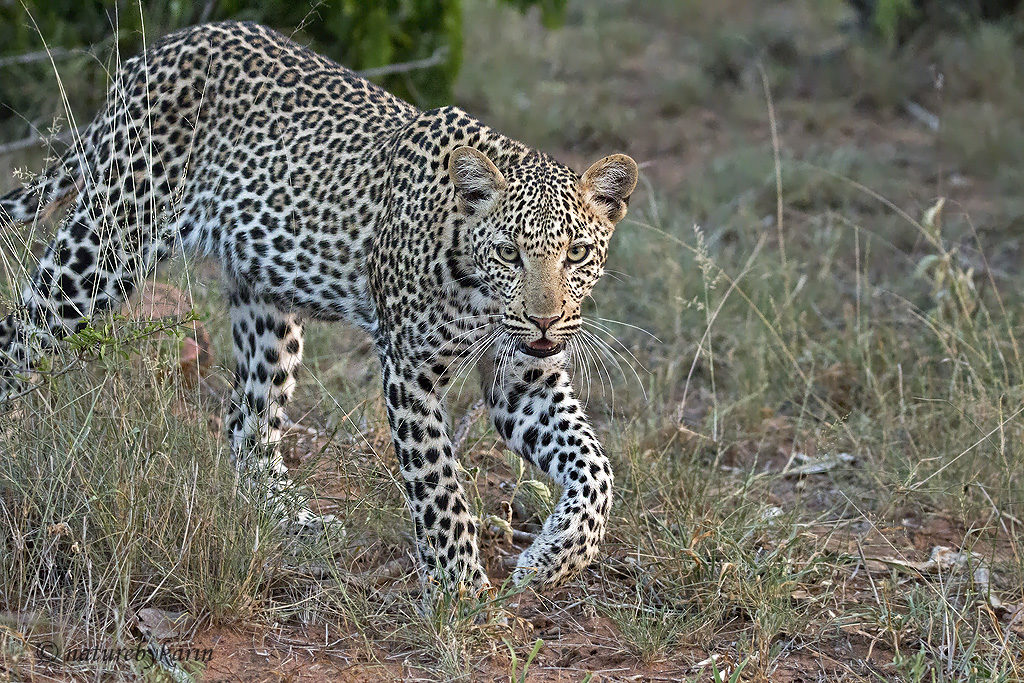
It then became obvious why they did not leave – they had a kill next to the road. This became visible when the light improved. The young leopard posed beautifully on top of the log before jumping down to start feeding.
She was not very visible while feeding, but I managed a few shots.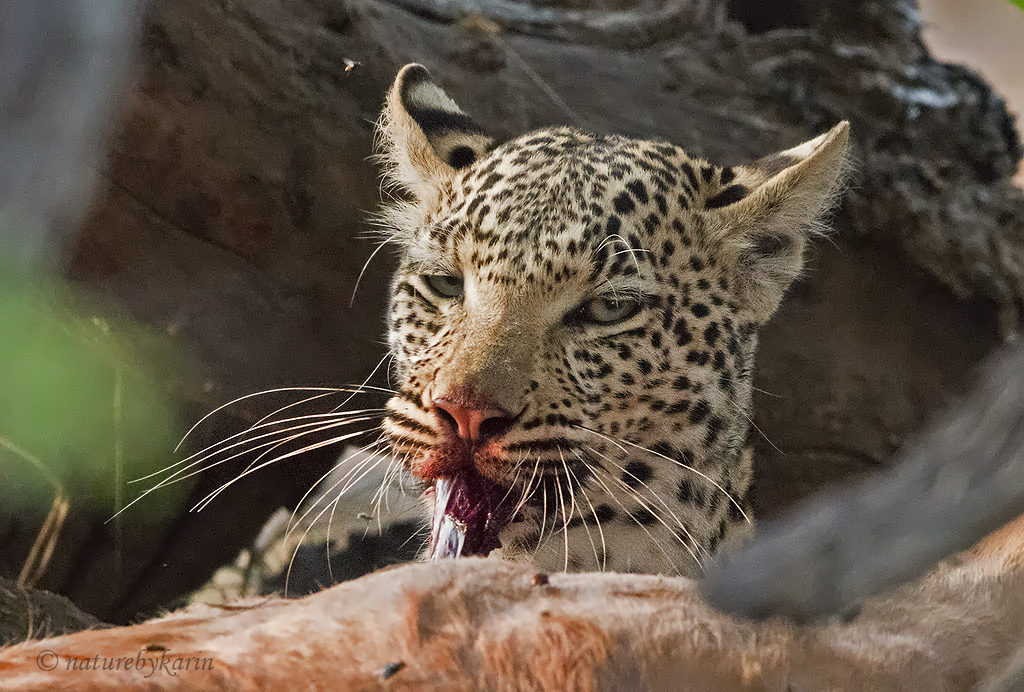
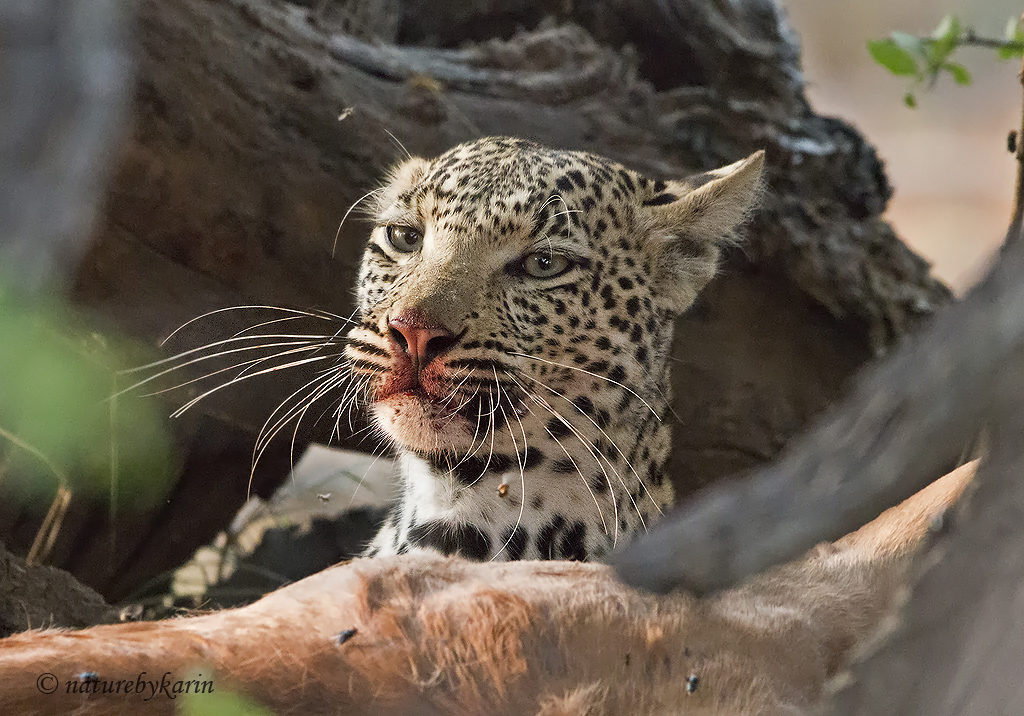

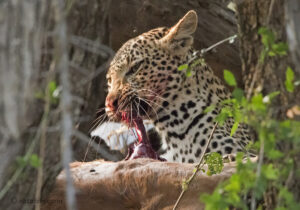
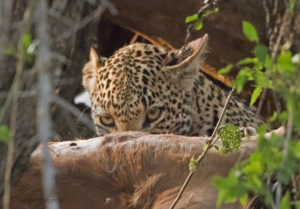
I had now spent almost 90 minutes at the sighting and I decided to give the other 4 cars that had now arrived the opportunity to enjoy them. Given that they had food, I also thought they may be around a while.
As so often happens to me in Kruger, I drove away incredulous. The timing of when I left the gate and the decision to take out the flashlight was just to perfect!
I spotted a young Dark Chanting Goshawk.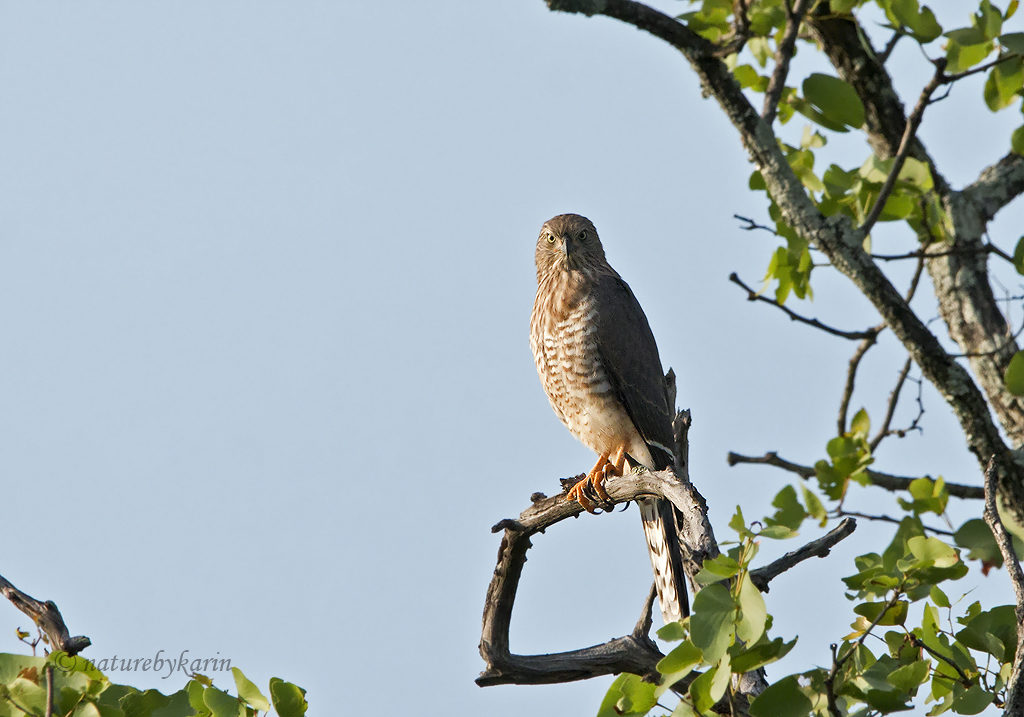
Shortly after turning left at the T-junction, a Common Button quail crossed the road in front of my car. I could only get a record shot.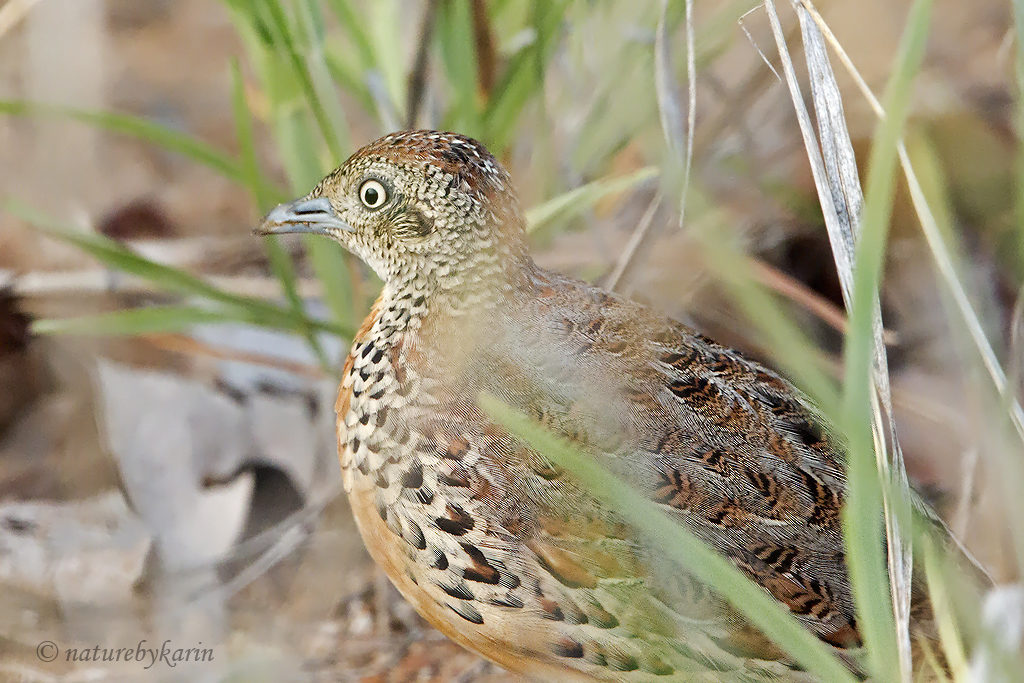
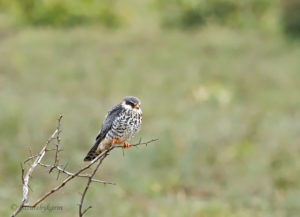 A little while later I had only my second Amur Falcon sighting of the summer I was happy to see three birds. It has been a quiet summer for me as far as these birds are concerned.
A little while later I had only my second Amur Falcon sighting of the summer I was happy to see three birds. It has been a quiet summer for me as far as these birds are concerned.
The rest of the drive to Klopperfontein was fairly quiet.
 There was not a lot of activity at Klopperfontein either except for a few Egyptian geese and Blacksmith Lapwings, and this Lanner Falcon.
There was not a lot of activity at Klopperfontein either except for a few Egyptian geese and Blacksmith Lapwings, and this Lanner Falcon.
Despite the lack of activity, I took a moment to enjoy the quiet. I poured coffee and enjoyed some rusks. Again, this was just one of those really peaceful moments that I could relax in the quiet and just reflect on the trips so far.
While enjoying the moment, I also decided on my plans for the day. I decided to drive back to camp and spend the rest of the day in camp and at the hide.
The drive back was as quiet as earlier. I did see the Amur falcons again and and a steenbokkie.
Then a Black spot caught my eye. I reversed, thinking it is probably another Jacobin Cuckoo. Great was my surprise and delight to see that it was in fact a Leveillant’s Cuckoo with Breakfast. He was enjoying a juicy, fat, green grub.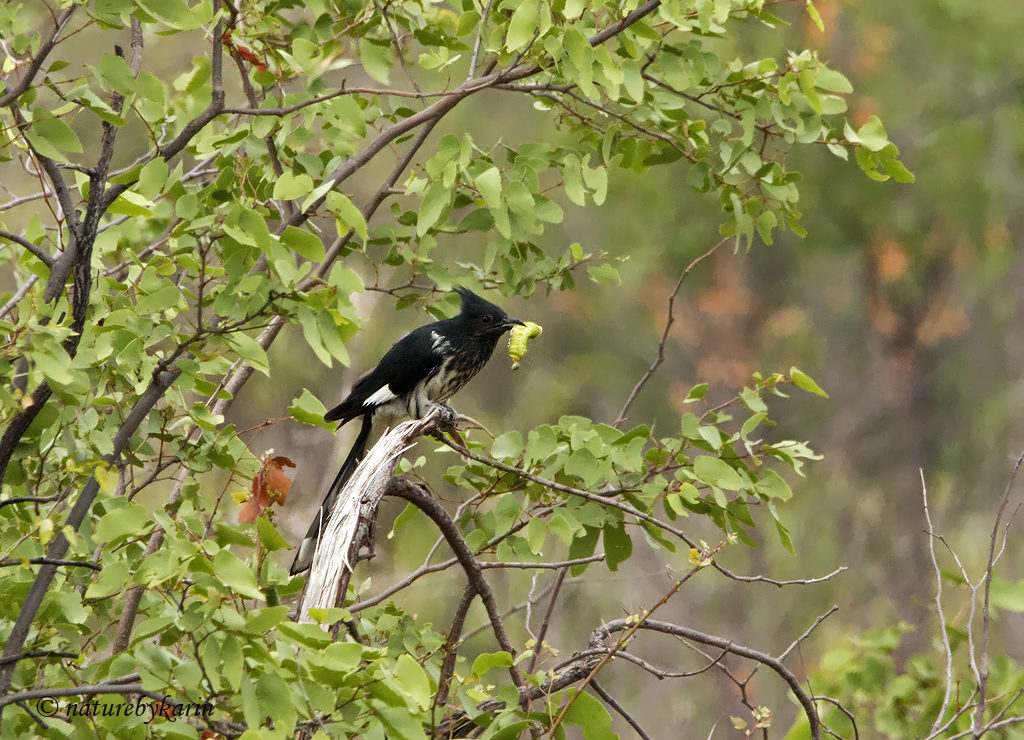
When I arrived at the leopard sighting they were still there. The one was walking next to the car and then crossed the road.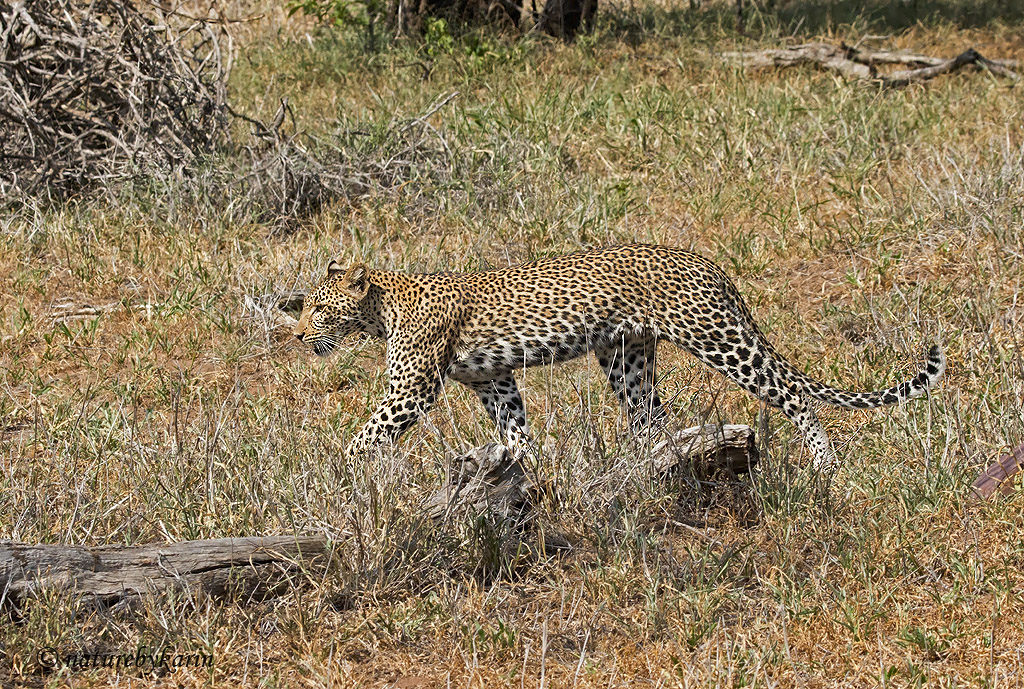
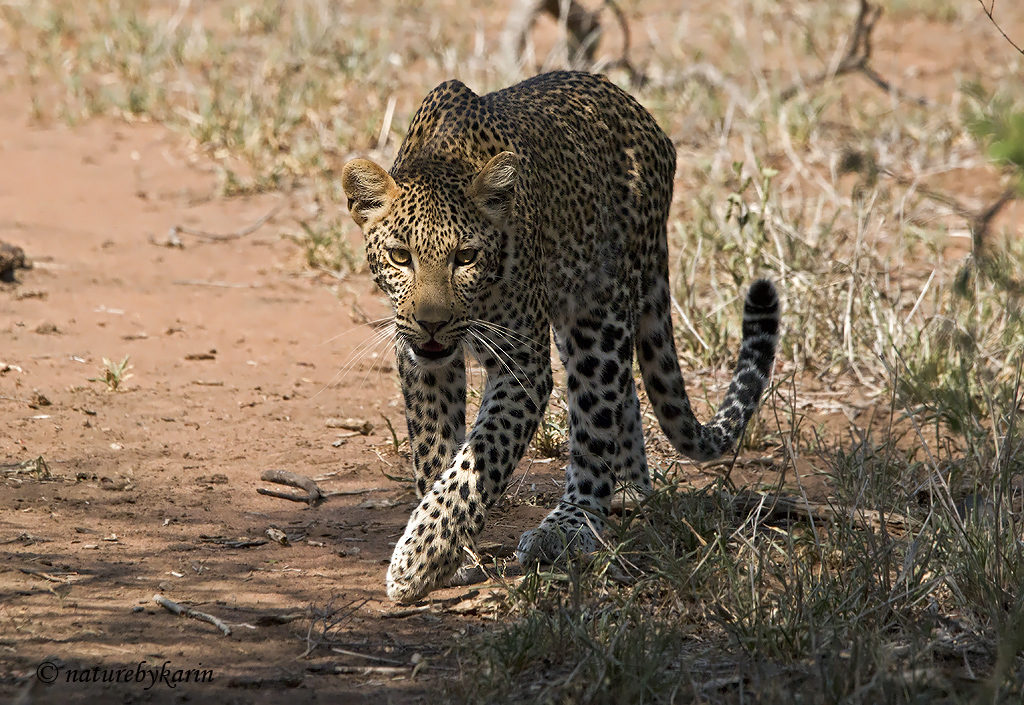
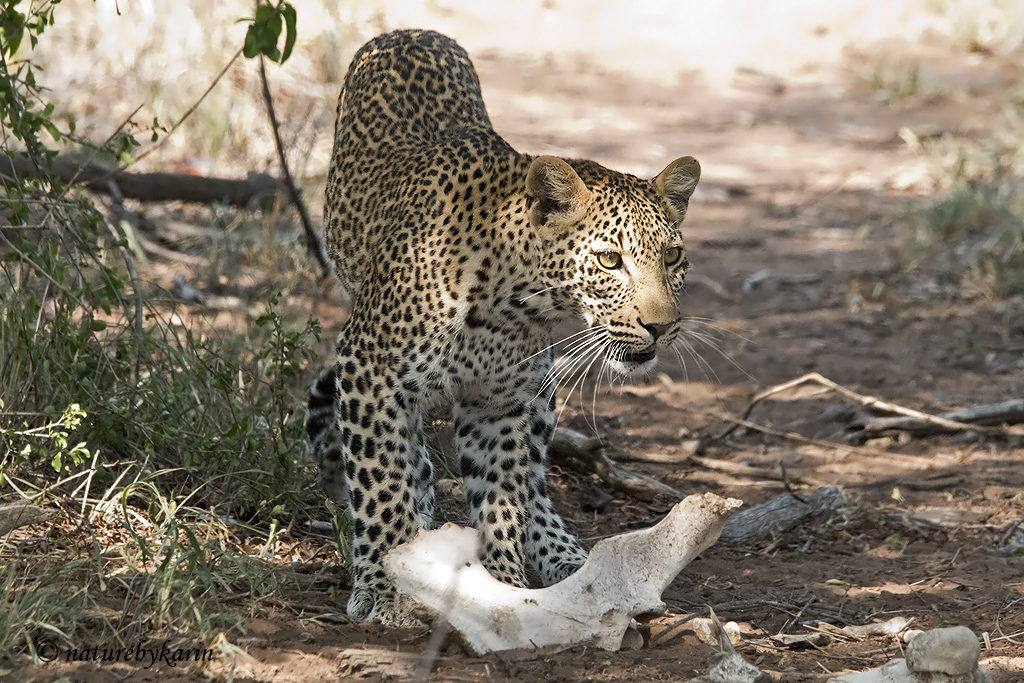
The two of them then relaxed in a tree next to the road for a short while.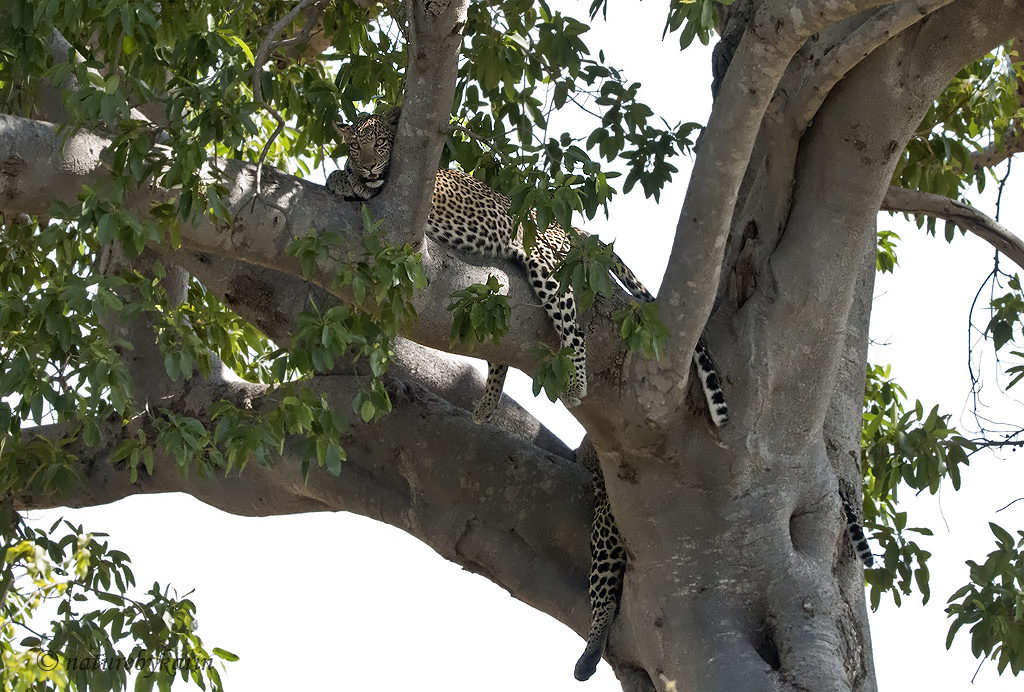
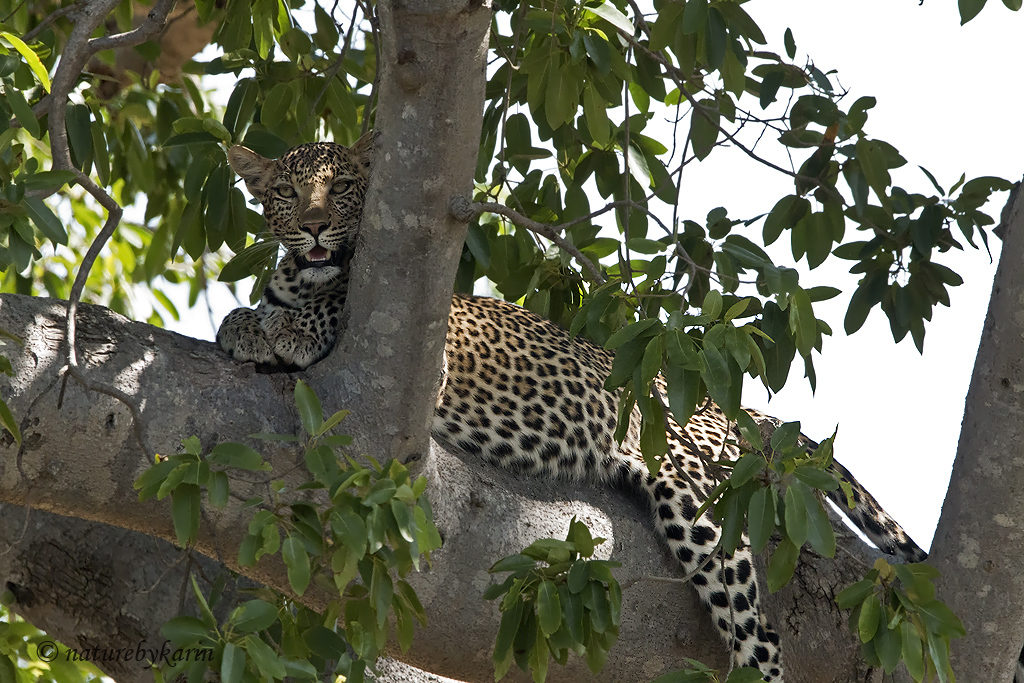
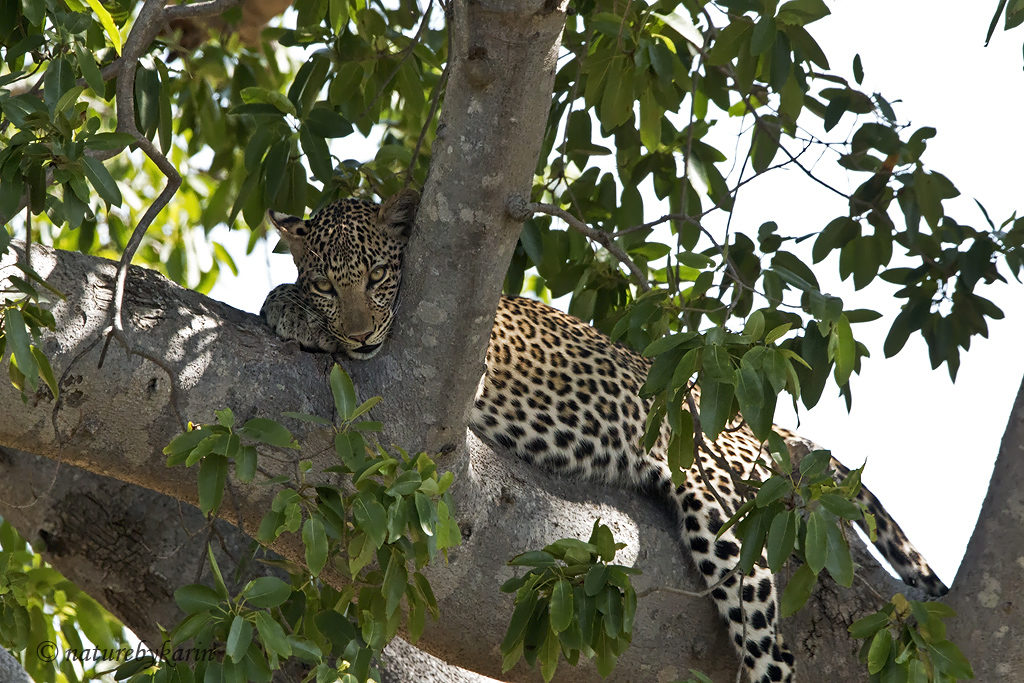
Then they got down and disappeared. First the one.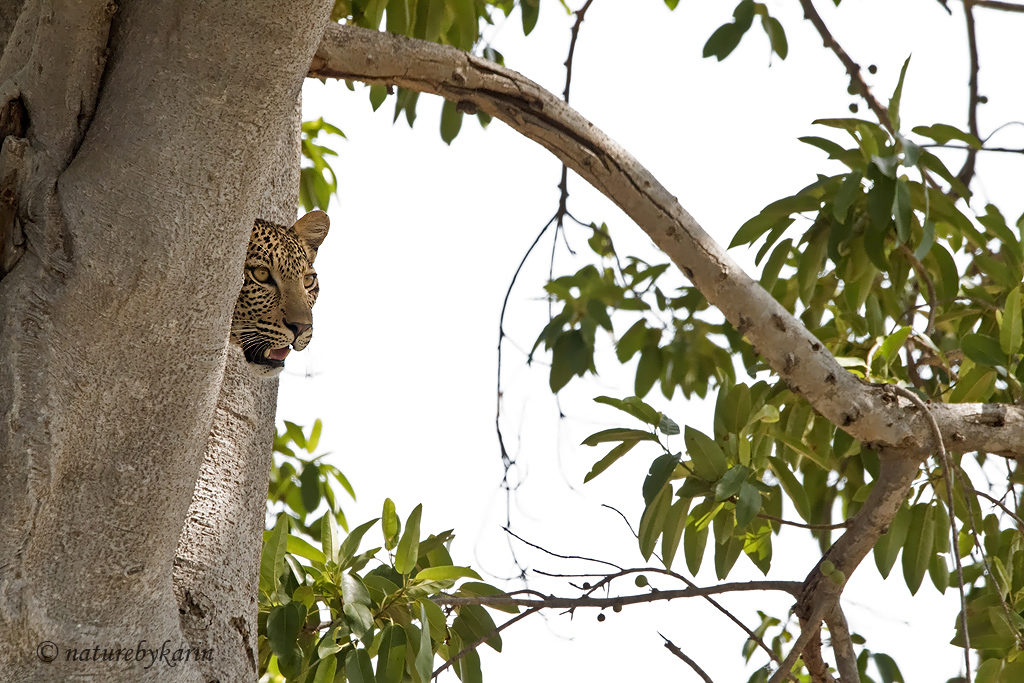
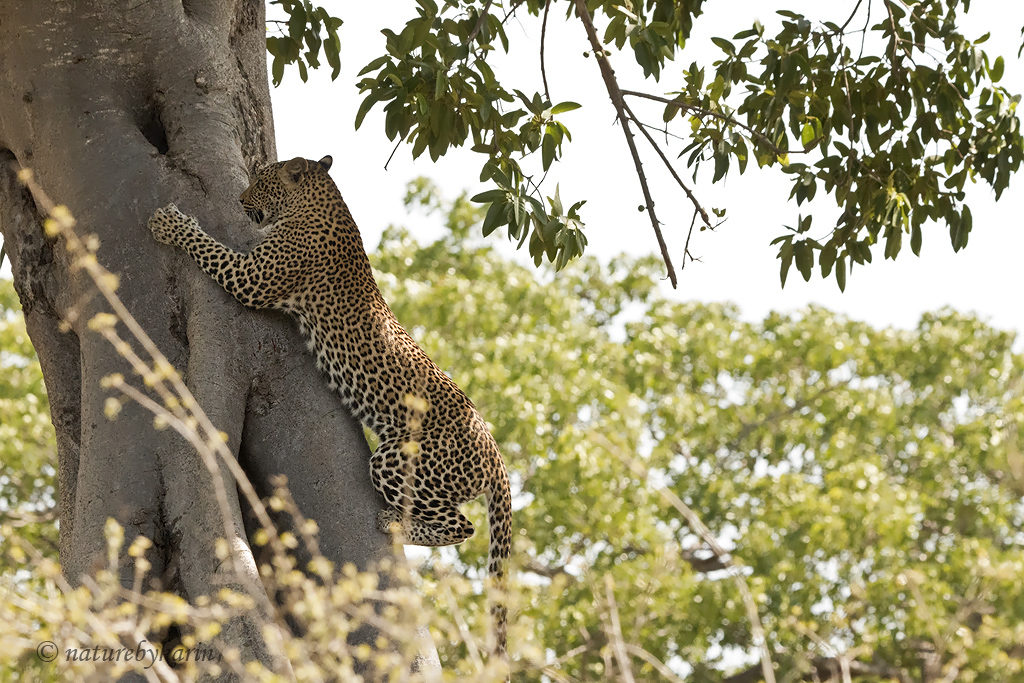
It has been the most incredible leopard sighting I have ever had.
I went to the hide and had a picnic. As has been the case before, there was a constant stream of animals at the hide.
I also added a Purple Indigo Bird to my trip list. And then it happened – I added a bird to my Kruger list that I did not want to add. Two Indian Mynas came for a drink. I could not believe it. It was my firsts ever sighting of these birds in the Park, and I was seriously annoyed.
As I arrived at my bungalow, the Crested Guineafowl were at the braai area. These guys are really quite tame.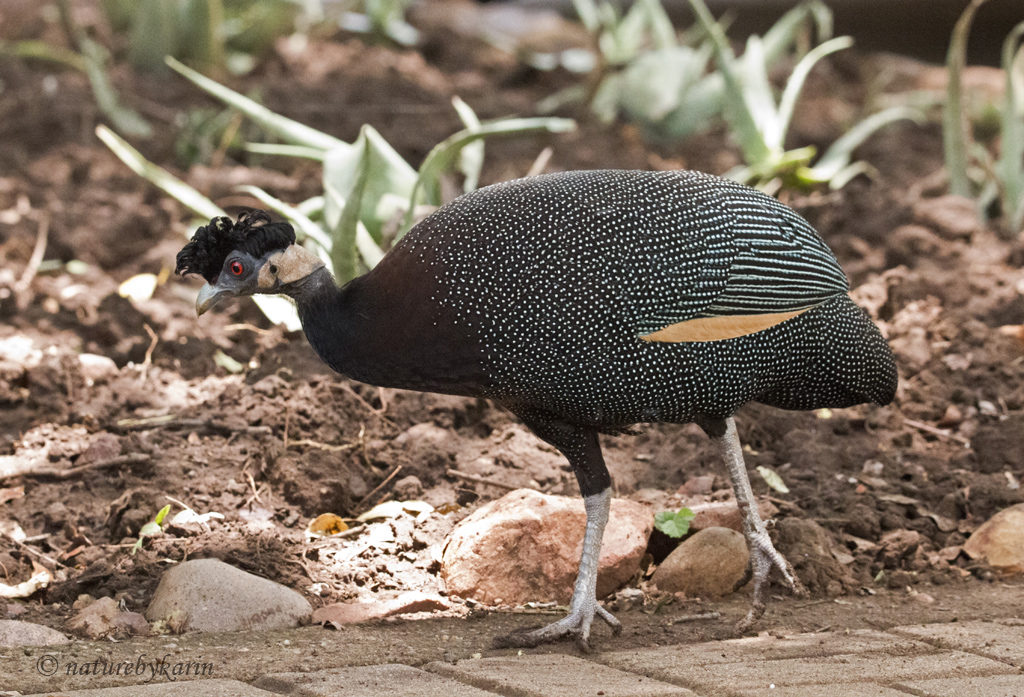

At about mid-day I went for a walk on the Flycatcher trail. I managed a photo of the Bearded Scrub-robin. I also saw two Boubous, Yellow-breasted Apalis, a Brown-hooded Kingfisher, Dusky Flycatcher and Jameson’s Firefinch.
After lunch I went back to the hide. A few Marabou storks came for a drink.
The stream of animals continued unabated.
A herd of elephants joined the party – my favourite source of entertainment!
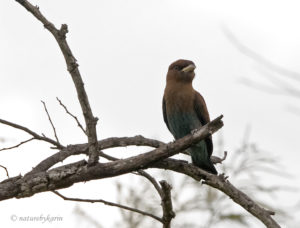 I went for a short drive just to see if the leopards were still around. Just inside the gate of the camp was a Thick-billed Roller. The leopards were nowhere to be seen, and I headed back to camp.
I went for a short drive just to see if the leopards were still around. Just inside the gate of the camp was a Thick-billed Roller. The leopards were nowhere to be seen, and I headed back to camp.
After supper I went back to the hide. There were some Double-banded Sandgrouse. At almost exactly the same time as the previous night the leopard came for a drink. Once again he hung around for quite a while before he walked away. Another splendid end to an incredible day!
Friday
Today was going home day. I decided to drive the Mahonie loop before I headed home. I drove in an anti-clockwise direction.
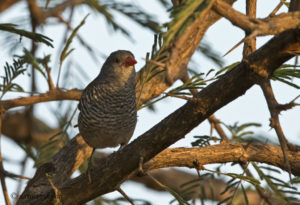 One of the first birds that I listed was a Kurrichane Thrush. I also spotted some Pytillias. There was a large herd of Impalas with some youngsters.
One of the first birds that I listed was a Kurrichane Thrush. I also spotted some Pytillias. There was a large herd of Impalas with some youngsters.
 I spotted a bird high up against the hill – I was now able to tick all five Hornbill species in the Park, but unfortunately the Crowned Hornbill flew off as I lifted the camera, so I only got a bit of a bum shot. I also spotted another Steppe Buzzard. There were loads of birds on the first half of the loop. A new bird for the trip was a Southern Black Tit. There was another Black-shouldered Kite. There were lots of Nyalas around and I saw a small herd of buffalos in the stream next to the road.
I spotted a bird high up against the hill – I was now able to tick all five Hornbill species in the Park, but unfortunately the Crowned Hornbill flew off as I lifted the camera, so I only got a bit of a bum shot. I also spotted another Steppe Buzzard. There were loads of birds on the first half of the loop. A new bird for the trip was a Southern Black Tit. There was another Black-shouldered Kite. There were lots of Nyalas around and I saw a small herd of buffalos in the stream next to the road.
The second half of the loop was rather quiet with a White-browed Scrob-robin, a Paradise Flycatcher and Gabar Goshawk in the distance the only notable sightings.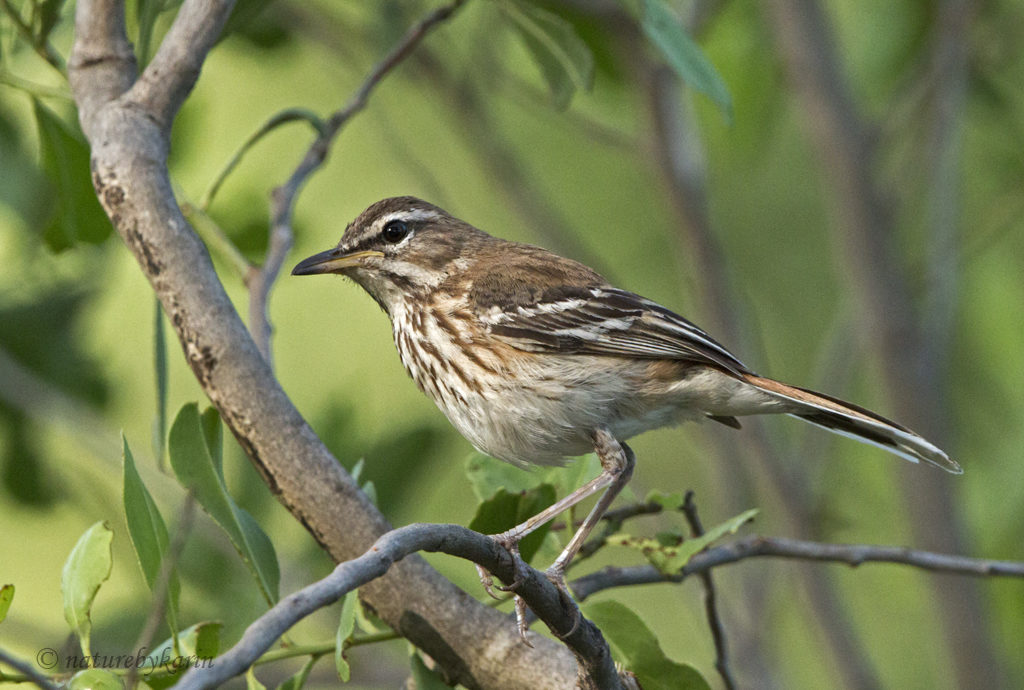
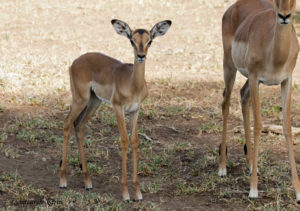 There were more impalas before the camp. I really enjoyed seeing so many younsters. Just before the camp gate I was held up by a large herd of buffaloes crossing the road.
There were more impalas before the camp. I really enjoyed seeing so many younsters. Just before the camp gate I was held up by a large herd of buffaloes crossing the road.
.
I stopped at the hide again before I left. There were some piglets.
The buffalo herd from earlier were at the waterhole. here were also kudus and some birds.
All too soon I was headed in the direction of the gate. There was a pair of duikers just in from the Mahonie loop entrance.
Drove to the Tulamela waterhole, and was able to add my 164th and final species for the trip – A Dusly Lark.
It had been an incredible trip. It was only my second trip to that area of the Park, and the longest I’ve stayed there. I LOVE the south of the Park and Skukuza, but I now have another serious favourite camp. Punda Maria camp is a little gem. The birdlife is incredible (I added 13 new species to my Kruger list) and although I did not see as many animals as I would in the south, but it was still amazing.
I can’t wait to come back!
You can find a few more photos from the trip here.
